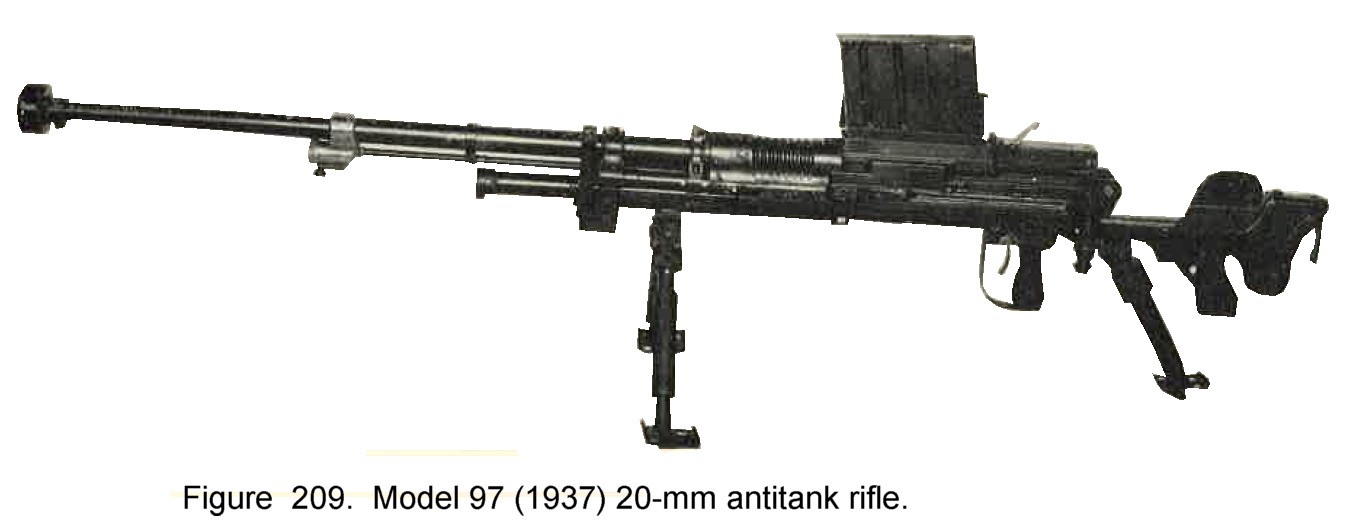CHAPTER 9 SECTION c - WWII JAPANESE WEAPONS

5. WWII JAPANESE ANTITANK AND INFANTRY GUNS
a. General.
(1) The Japanese infantry is comparatevily well armed. The first effort to give heavy weapons to the infantry was 1921 - 1922, when the Model 10 (1921) 50-mm grenade discharger, the Model 10 (1921) 70-mm mortar, and the Model 11 (1922) 37-mm gun were introduced. These three weapons were later replaced by the Model 89 (1929) 50-mm grenade discharger, the Model 92 (1932) 70-mm batalion Howitzer, and the model 94 (1934) 37-mm gun. However, in some areas the older weapons are still in use.
(2) In 1936, the Model 41 (1908) 75-mm mountain gun was replaced by a newer weapon in the mountain (pack) artillery units. The Model 41 gun then was issued four to each infantry regiment and is known as the regimental gun. This move gave the infantry a lightweight 75-mm weapon of its own.
(3) When first issued, Model 11 (1922) 37-mm gun was no doubt intended in part for an anti-tank role, although it could not be considered a threat today. Its successor, Model 94 (1934) 37-mm gun, has a much higher velocity.
(4) It was not until 1937, however, that the Japanese produced a purely antitank weapon. Model 97 (1937) 20-mm antitank rifle is a hard hitting mobile weapon. Model 98 (1938) 20-mm antiaircraft antitank machine cannon can also be used against tanks.
(5) With the appearance of Model 1 (1941) 47-mm gun, a modern, mobile, high velocity weapon, Japanese antitank weapons take on a much more serious aspect.
(6) The fact that Model 41 (1908) 75-mm infantry gun is provided with armor piercing, high explosive and hollow charge AP ammunition must be borne in mind, because this gun is so widely distributed in the Japanese army.
(7) Japanese infantry must be considered well supplied with heavy weapons; the Army is primarily an infantry army, and the weapons of the infantry have always been the first consideration of the military.
b. Model 97 (1937) 20-mm antitank rifle.
(1) General description. This is actually a single purpose, selective full or semi-automatic gas operated, antitank automatic cannon (fig. 209). Infantry can maneuver it in any sort of terrain. Two men can carry it, since it weighs but 150 pounds complete with shield and carrying handles, and it is easy to hide because of its low silhouette (16 1/2 inches without the shield). However, its sights do not permit accurate laying for the longer ranges, and tracking is difficult because traversing must be accomplished by shoulder control. In addition the weapon has a very violent recoil. The Japanese markings
 which mean "97 Model" appear on top of the receiver.
which mean "97 Model" appear on top of the receiver.
(3) Ammunition. Armor piercing tracer and high explosive tracer ammunition has been recovered.
c. model 98 (1938) 20-mm antiaircraft, antitank automatic cannon.
(1) General description. This is a gas operated, semi or full-automatic, all purpose weapon (fig. 210), similar in mechanism, but larger and heavier than the Model 97, 20-mm antitank rifle. The ammunition is not interchangeable. The cartridge permits firing from its wheels Supported on outriggers with wheels removed it has a fast 360 degree traverse.
|
(2) Characteristics. Caliber --------------------------------------------------------- 20-mm (0.79 inch). Type feed -------------------------------------- 20 round box magazine. Weight ------------------------------------------- 836 pounds (without wheels). Traverse ---------------------------------------- 6,400 mils (360 degrees). Maximum range - vertical -------------------------------------- 12,000 feet. Maximum range - Horizontal ----------------------------------- 5,450 yards. Muzzle velocity (armor piercing ammunition) ------- 2,720 feet per second. Rate of fire -------------------------------------- 120 rounds per minute. Principle of operation. -------- Gas operated, semi or full automatic. |
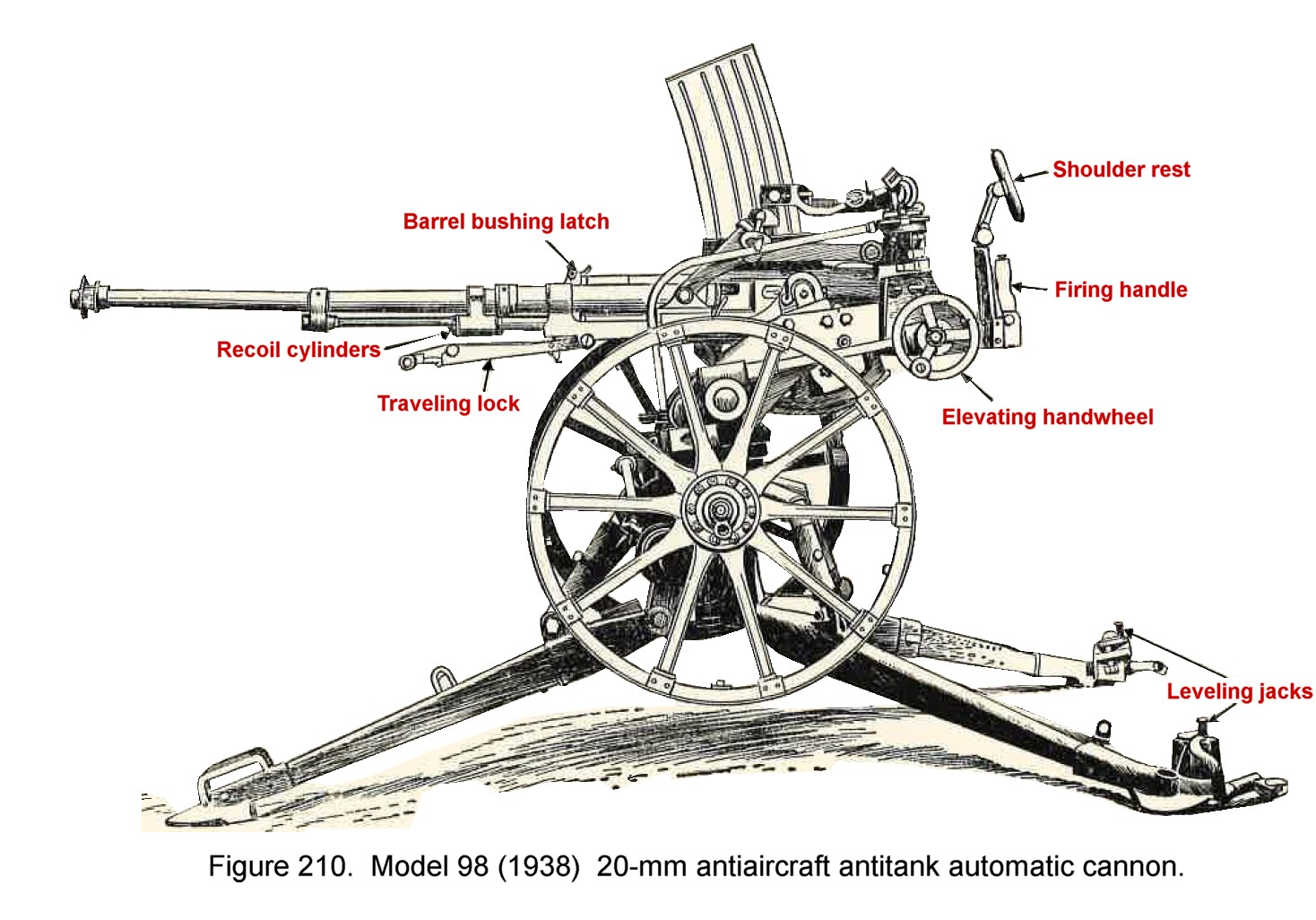
|
(3) Ammunition. High explosive tracer and armor piercing tracer have been recovered.
d. Model 11 (1922) 37-mm gun.
(1) General description. This weapon (fig. 211) was still in use in some areas in 1944, although its place in the infactry organization has been taken by Model 94 (1934) 37-mm gun and other antitank weapons. It resembles the U.S> 37-mm infantry gun, M 1916. The gun is carried by four men. This weapon is listed by the Japanese as
 which is translated "11th year model low trajectory
infantry gun".
which is translated "11th year model low trajectory
infantry gun".
(2) Characteristics.
|
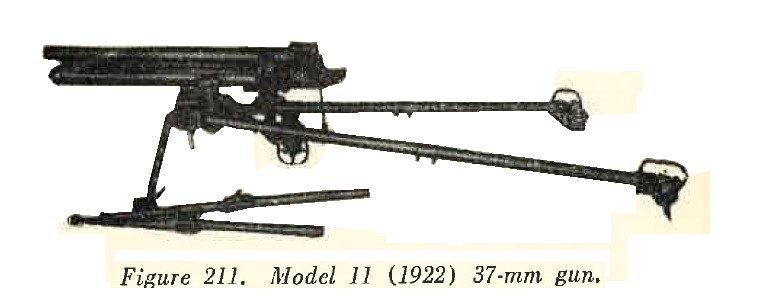
|
e. Model 94 (1934) 37-mm gun.
(1) General description. This weapon (fig.212) is referred to by the Japanese as the "Infantry rapid fire gun". It is an infantry close support weapon firing both high explosive and armor piercing high explosive ammunition. It has a semiautomatic, horizontal, sliding type breechlock. When the shell is loaded, the rear of the cartridge case trips a catch that closes the breechlock. Recoil action of firing opens the nreech and extracts the cartridge case. Sighting is by a straight telescoopic sight. This weapon has marked on the varrel the following
 which reads "94 model 37-mm gun".
which reads "94 model 37-mm gun".
|
(2) Characteristics. Caliber --------------------------------------------------------- 37-mm (1.46 inch). Length (over all in travelling position) -------------------- 114 inches. Width (overall in travelling position) ----------------------- 47 inches. Weight ------------------------------------------- 714 pounds. Traverse ---------------------------------------- 1,062 mils (60 degrees) Elevation ---------------------------------------- +480 mils (27 degrees) Maximum range ----------------------------------- 5,000 yards. Muzzle velocity (armor piercing ammunition) ---------- 2,300 feet per second. |
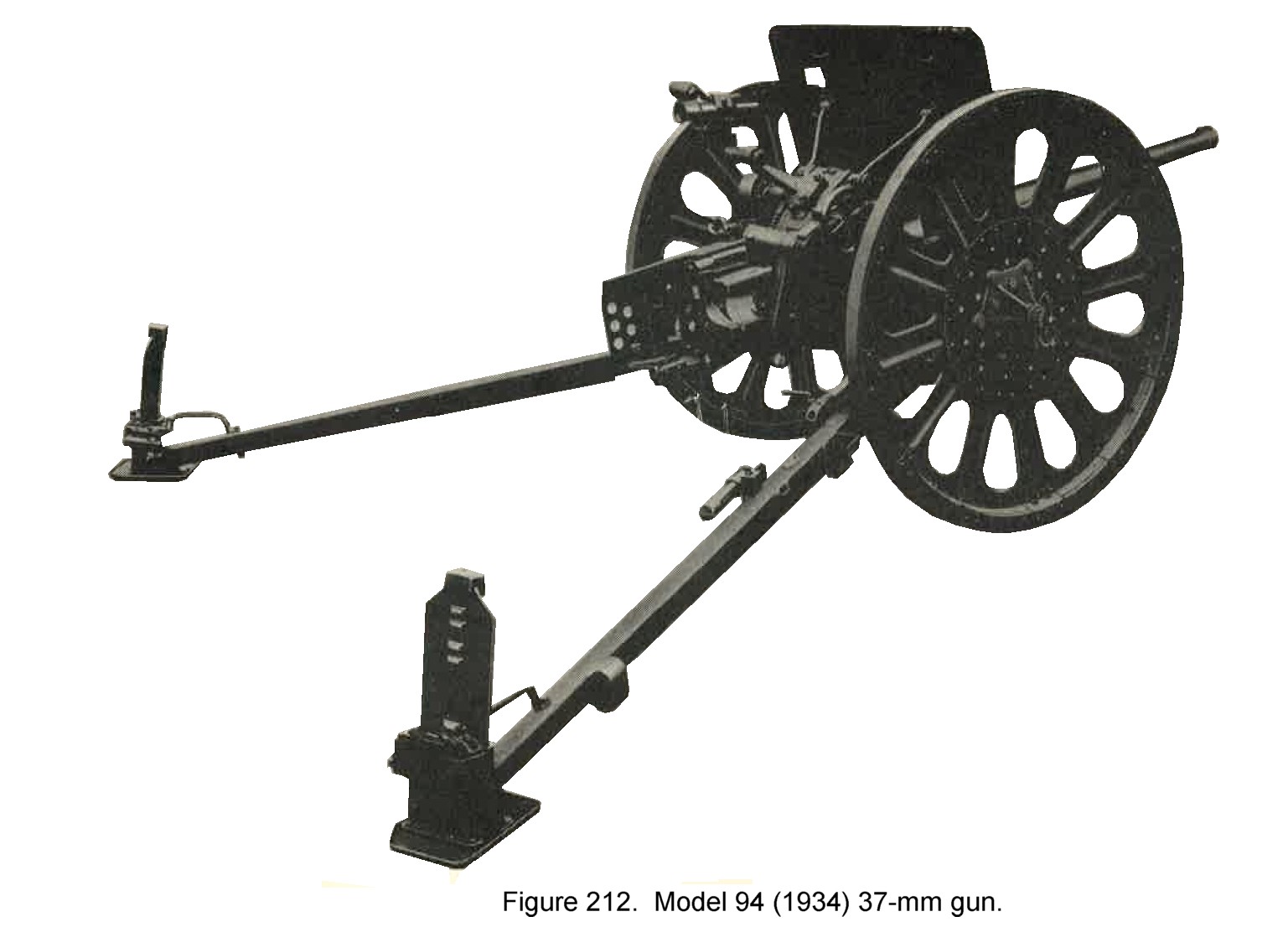
|
f. Model 1 (1941) 47-mm gun.
(1) General description. This is an antitank weapon of modern design (fig 213). The wheels are independantly sprung, and a lock is provided in each wheel for locking the springs out of action. It has a semiautomatic, horizontal, sliding wedge bridge mechanism. The low silhouette, wide tread, and long split trails give this gun excellent stability. Preliminary tests indicate a muzzle velocity of 2,700 feet per second. The steel wheel discs are outfitted with sponge rubber filled tires. This weapon has marked on its breech the following symbols
 which mean "Model 1 47-mm mobile gun".
which mean "Model 1 47-mm mobile gun".
|
(2) Characteristics. Caliber --------------------- 47-mm (1.85 inch). Weight ---------------------- 1,600 pounds. Traverse -------------------- 60 degrees. Elevation -------------------- +19 degrees. Depression ------------------ -11 degrees. Muzzle velocity ------------- 2,700 feet per second. |
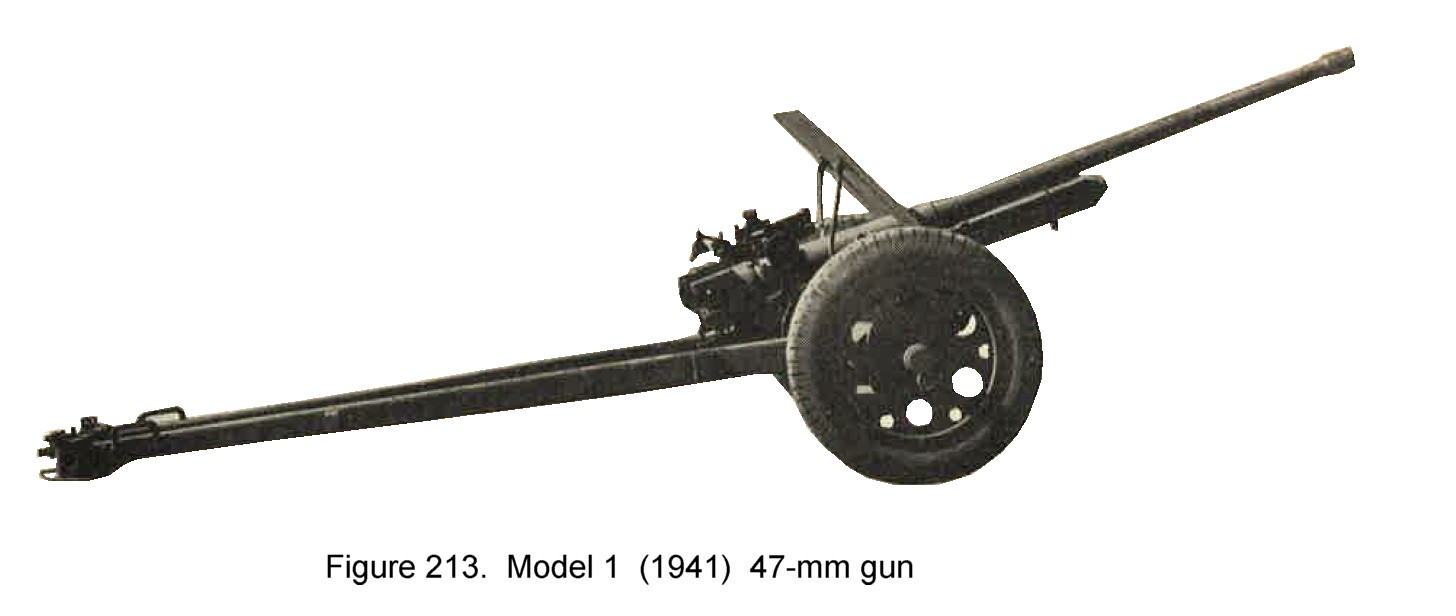
|
(3) Ammunition. Armor piercing high explosive and standard high explosive shells have been recovered.
g. Model 92 (1932) 70-mm Howitzer (batallion gun).
(1) General description. This weapon (fig. 214), despite its unusual appearance, has proved to be effective as an infantry support Howitzer. It has an interrupted thread type, drop breech block mechanism. Light in weight and maneuverable, it fires a projectile of relatively large weight, and can deliver fire at ranges varying from 110 yards to 3,000 yards. The Japanese markings
 which
read "92 model infactry gun", appear on the barrel.
which
read "92 model infactry gun", appear on the barrel.
|
(2) Characteristics. Caliber ------------------------------------ 70-mm (2.76 inch). Total weight in action ------------------ 468 pounds. Thickness of armor shield -------------- 0.156 inch. Traverse ---------------------------------- 800 mils (45 deg total). Elevation -------------------------------- +50 deg. Depression ------------------------------- -10 deg. Range ------------------------------------- 3,075 yards. Danger area of burst ------------------- 40 yards (approximately). |
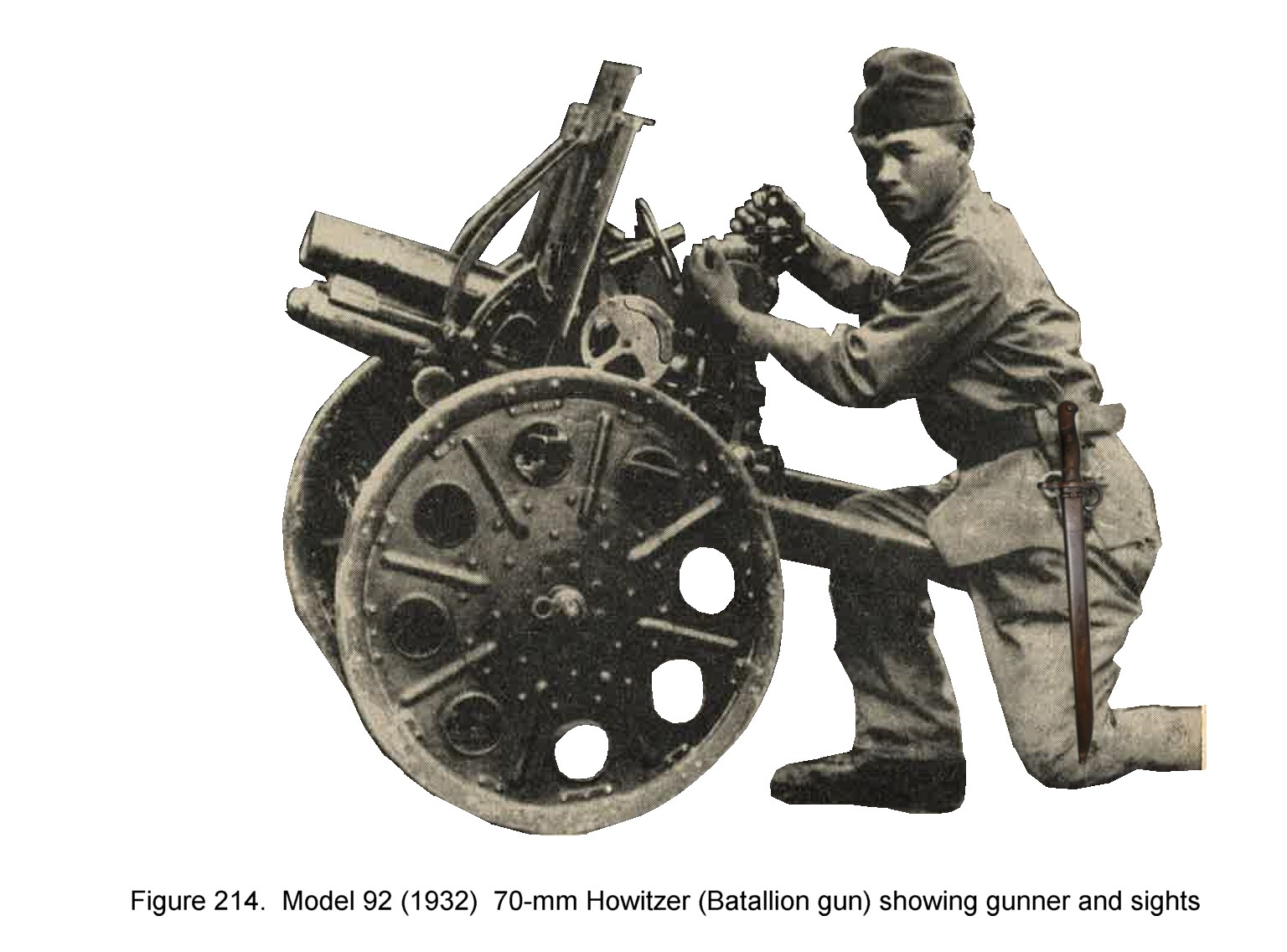
|
(3) Ammunition. The ammunition is semifixed,the propelling charge being divided into four increments. High explosives, armor piercing, and smoke shells are fired. The standard model 88 delat and instantaneous fuzes are used.
h. Model 41 (1908) 75-mm Infantry Gun.
(1) general description . This weapon (fig. 215) was originally the standard pack artillery weapon, but when it was largely superseded by the Model 94 (1934) 75-mm mountain (pack) gun, it was then used as an infantry "regimental" gun. It is widely distributed throughout the Japanese Army. It has an interrupted screw type breechblock and a hydro spring recoil mechanism. There are no equalizers or equilibratiors. The markings
 which appear on the barrel, mean 41 mdoel mountain gun". This weapon may be easily and quickly
disassambled for pack into loads. The maximum weight of each being approximately 200 pounds. Actual firing of the weapon at a range of 3,200 yards
resulted in 75 percent of the rounds falling in a rectangle 20 by 30 yards. At maximum range (7,800 yards) 75 percent of the rounds fell within a
rectangle 100 yards wide and 200 yards long.
which appear on the barrel, mean 41 mdoel mountain gun". This weapon may be easily and quickly
disassambled for pack into loads. The maximum weight of each being approximately 200 pounds. Actual firing of the weapon at a range of 3,200 yards
resulted in 75 percent of the rounds falling in a rectangle 20 by 30 yards. At maximum range (7,800 yards) 75 percent of the rounds fell within a
rectangle 100 yards wide and 200 yards long.
(2) Characteristics.
|
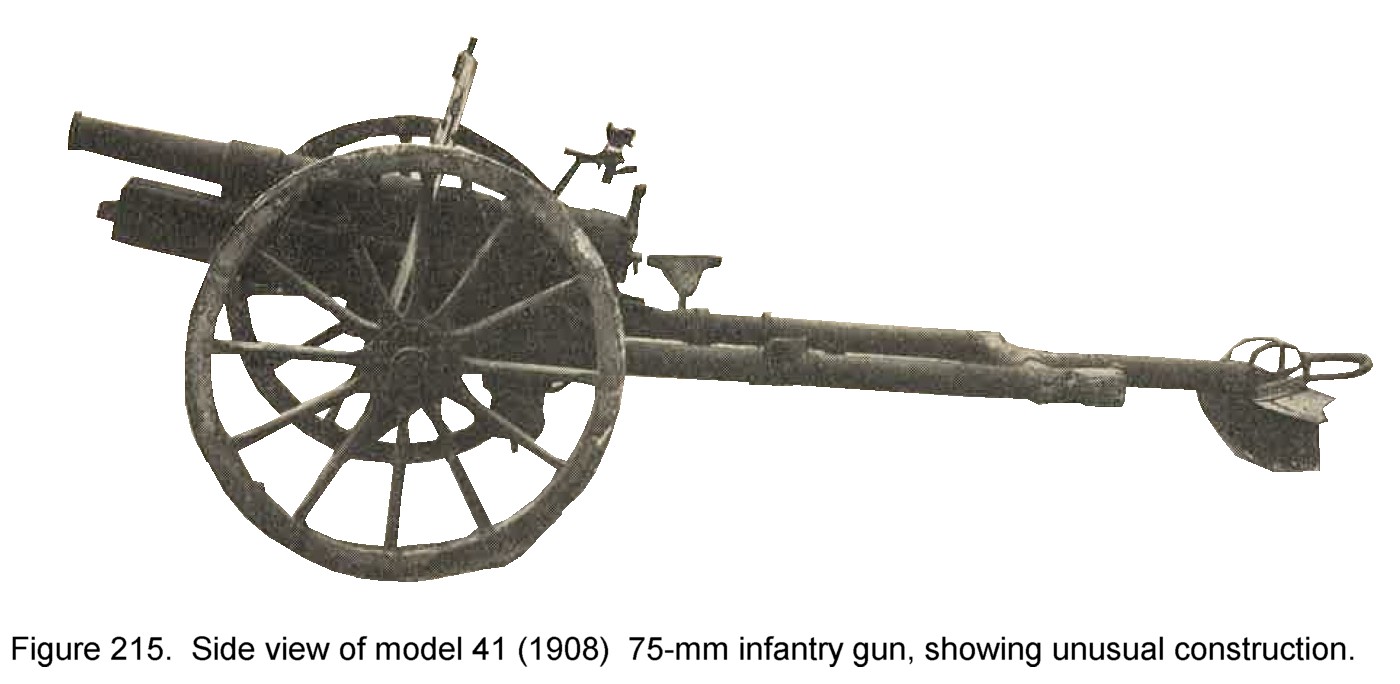
|
(3) Ammunition. Ammunition recovered included comm,on high explosive, armor piercing, sharpnel, hollow charge AP and incendiary. For description of the incendiary shell see Chapter 9, Section V.

SECTION III - WWII JAPANESE ARTILLERY
1.GENERAL
Between 1925 adn 1936, all Japanese artillery pieces were either redesigned or replaced by newer designs. An examination of a majority of the designs known to exist leads to the belief that the following features will be incorporated in any newer designs produced since 1936, although no weapon over 47-mm in size and bearing a model date later than 1936 as yet have been reported:
- Hydropneumatic recoil system.
- Use of equilibrators.
- Muzzle breaks.
- Increased muzzle velocities.
- Improved high speed mounts on all medium and heavy pieces (using either pneumatic tires or tires filled with sponge rubber).
Since Japan has had access to German weapon design for some years, it may be assumed that the Japanese weapons embodying the following features may be encountered:
- Hollow charge projectiles.
- New incendiuary projectiles.
- Self propelled mounts of various kinds.
- Rockets.
2. FIELD ARTILLERY.
a. Model 94 (1934) 75-mm mountain (pack) gun.
(1) General description. This is the standard Japanese pack artillery piece (figure 216) which replaced the Model 41 mountain gun. Designed for rapid assembling and dismantling, it breaks down into 11 units, the heaviest of which weighs 210 pounds. The weapon is normally transported by 6 pack horses. It is characterized by a comparatively long split-trail hydropneumatic recoil mechanism, and a horizontal sliding breechblock. The shield is 1/8-inch armor plate.
(2) Characteristics.
(3) Ammunition. HE, AP, sharpnel, chemical, star, and incendiary. |
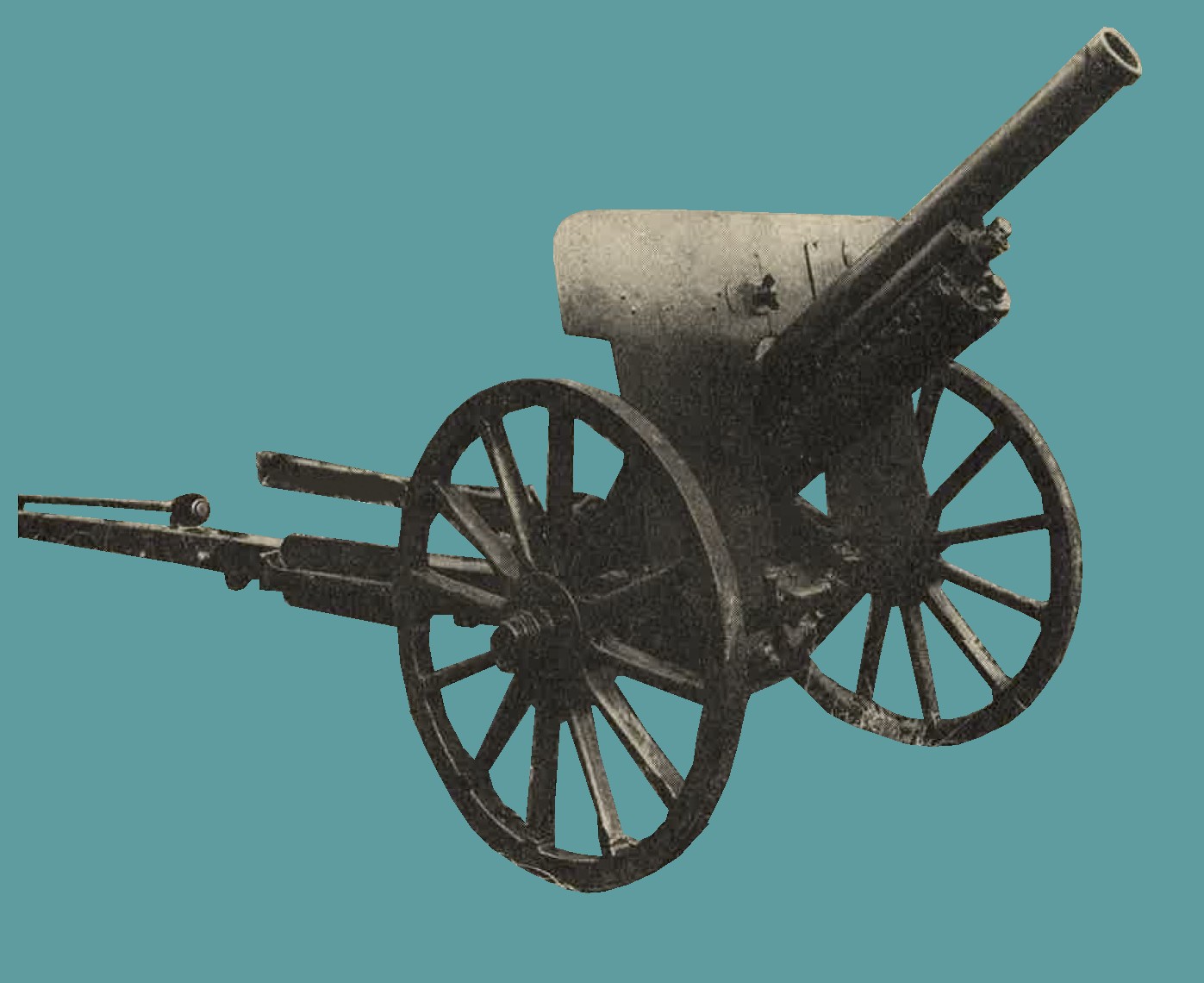
Figure 216. Model 94 (1934) mountain (pack) gun. |
b. Model 38 (1905) 75-mm gun.
General description.
(1) One of the early weapons of the Japanese division artillery, this weapon (figure 217) has been subject to considerable modification, and several versions are known to exist. There is no evidence that this parent model has been employed in recent operation; probably now it is regarded as obsolete (1944). It may be readuly identified by the single box trail which, by its design, considerably limits the elevation of the piece. Other characteristics are a hydrospring recoil system, interrupted screw type breechlock, and 1/16-inch shield.
2. Characteristics.
(3) Ammunition. HE and AP. |
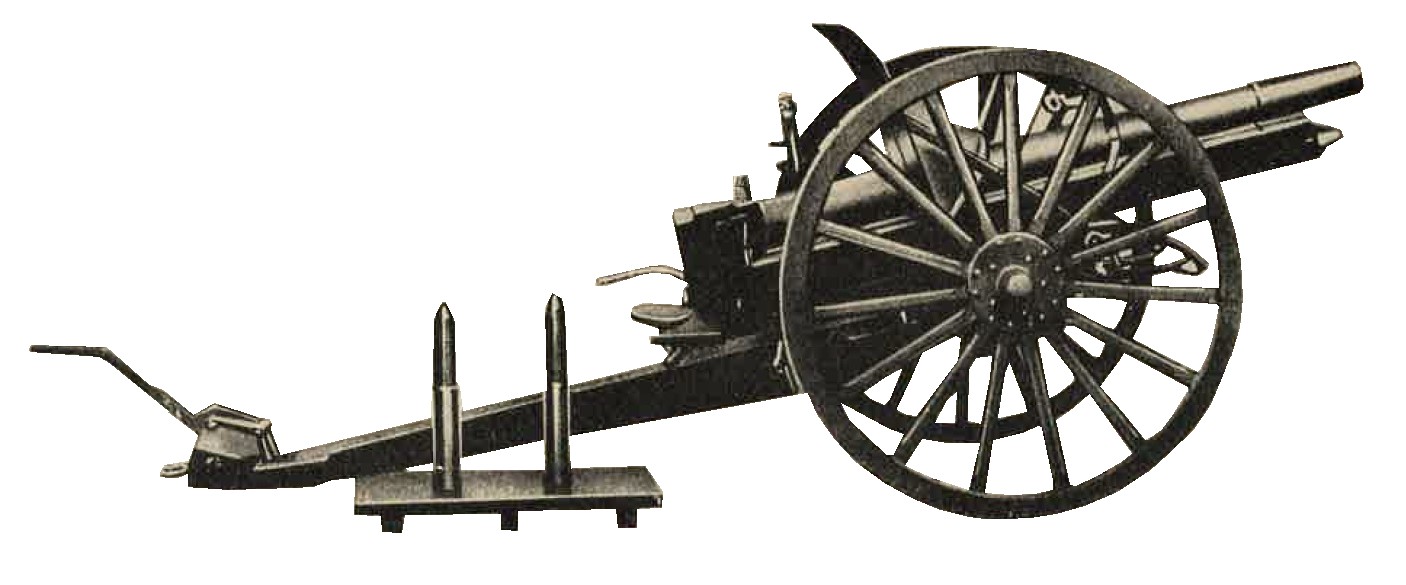
Figure 217. WWII Japanese 75-mm gun with ammunition. |
c. Model 38 (1905) gun improved (possibly 4th year model).
(1) General description. This is an improved version of the 75-mm model 38 (1905) field gun, which appears to have been entirely replaced. Modifications on the present model (figure 218) consists of trunnioning the barrel further to the rear; the addition of two spring and cable equilibrators to compensate for muzzle overhang; Replacement of the old box trail by a longer open box type through which the barrel can recoil at high elevations; change the breech to a horizontal sliding wedge mechanism, the most significant results of the above modification are a much longer range and increase rate of fire. Although reports have indicated that this weapon was to be replaced by the Model 90, the fact that the newer gun has not been encountered in any combat areas (as of 1944) indicates that this plan has not yet beeb consummated.
(3) Ammunition. HE, AP, sharpnel, smoke, star shell, and chemichal. |
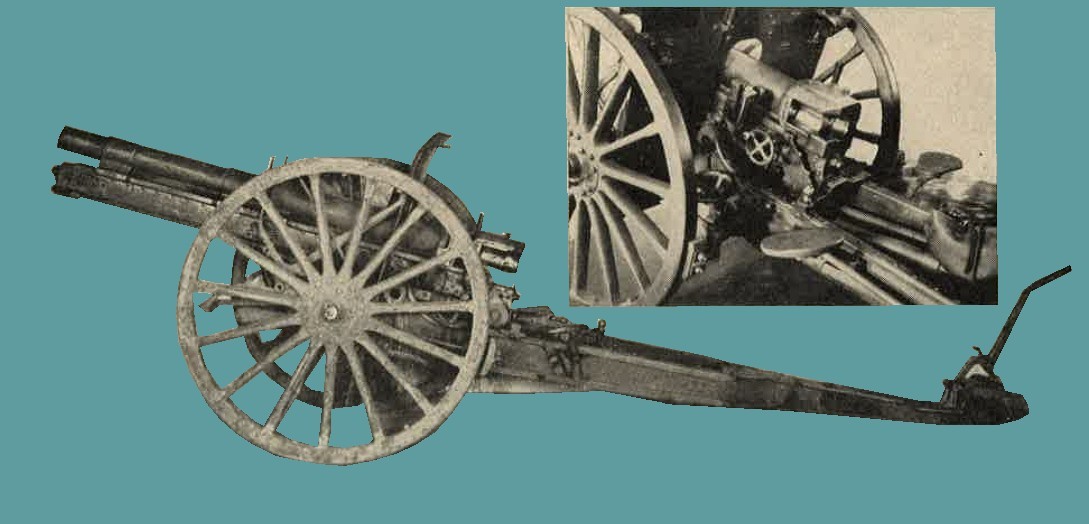
Figure 218. Japanese Model 38 (1905) gun improved (Insert shows breech mechanism). |
d. Model 90 (1930) 75-mm gun.
(1) Geenral description. Surrounded with considerable secrecy by the Japanese, this gun (figure 219) has been reported as the modern weapon of the division artillery. In 1936 it was believed to have been in process of issue to organizations, but to date (1944), it has not been encountered in any theater of war.
The gun is equipped with either pneumatic tires for motorized towing or large , steel-rimmed wheels for horse draft. It is characterized by a split trail, a horizontal sliding breechlock, and a hydropneumatic recoil system. An ususual feature is the muzzle break, which as of 1944, it had not been found on any other artillery piece.
(3) Ammunition. HE, AP, sharpnel, incendiary, smoke, star shell. |
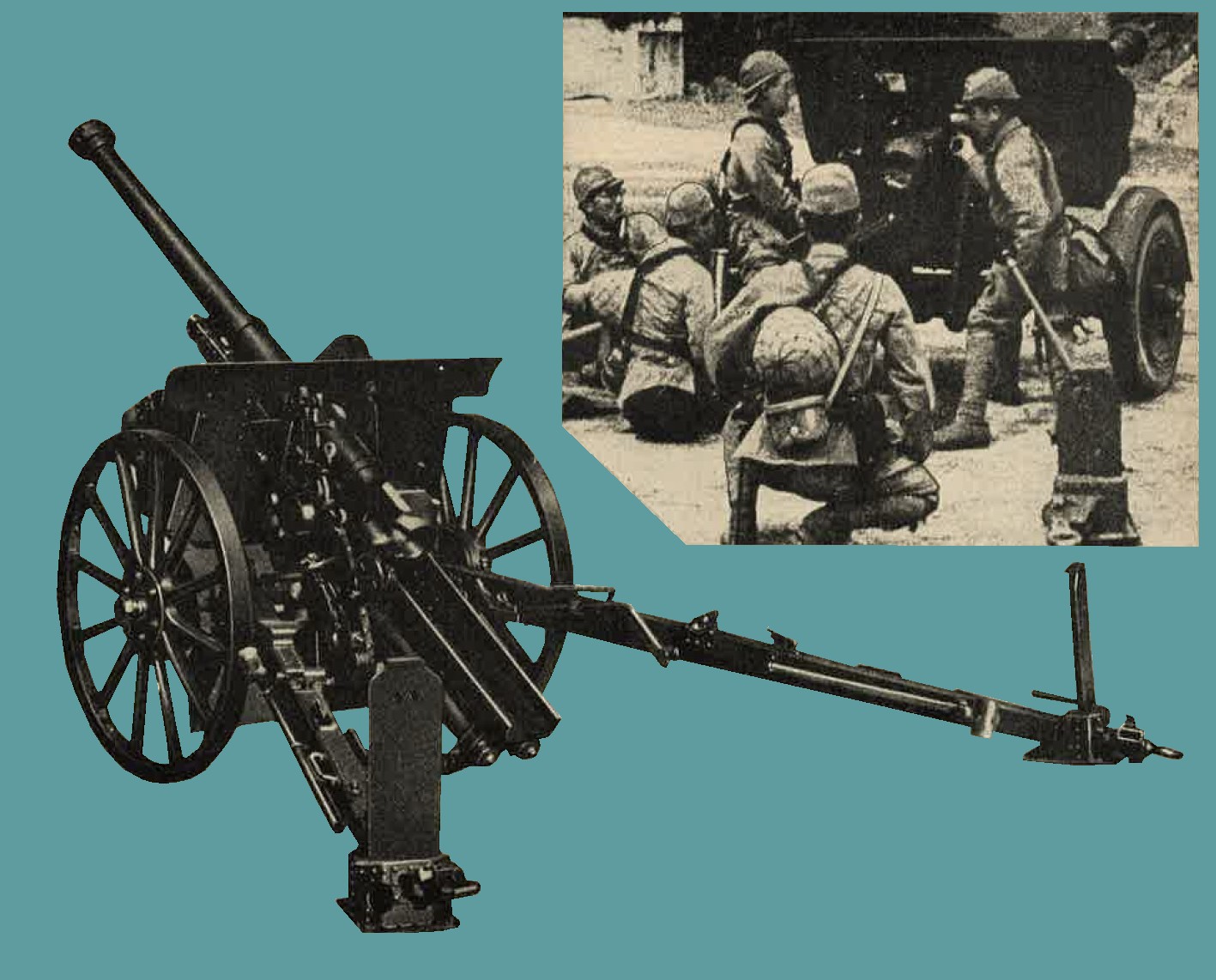
Figure 219. WWII Japanese Model 90 (1930) 75-mm gun (insert shows the weapon on a high speed carriage with pneumatic type tires). |
e. model 95 (1935) 75-mm gun.
(1) General description. The 75-mm Model 95 gun is a horse drawn (figure 220) with split trails, hydropneumatic recoil mechanism, and horizontal, sliding-wedge type breechlock. A comparison with the Model 90, designed 5 years earlier, reveals that this later weapon has only the apparent advantage of reduced weight. On the other hand, it suffers from loss of range and lower muzzle velocity. It is seemingly more rugged in construction than the Model 94 mountain gun and yet gives a lower performance than he Model 90 field gun.
The possibility therefore suggests itself that the Model 95 was not designed to replace other of these guns, but was to be used by some unit other than the field or pack artillery. It is possible therefore that it may be the new weapon of the horse artillery, replacing the old adaptation of the Model 38 with which such units previously had been equipped.
* Also reported as 9,000 meters (9,850 yards). (3) Ammunition. HE, AP, sharpnel, smoke star and chemical. |
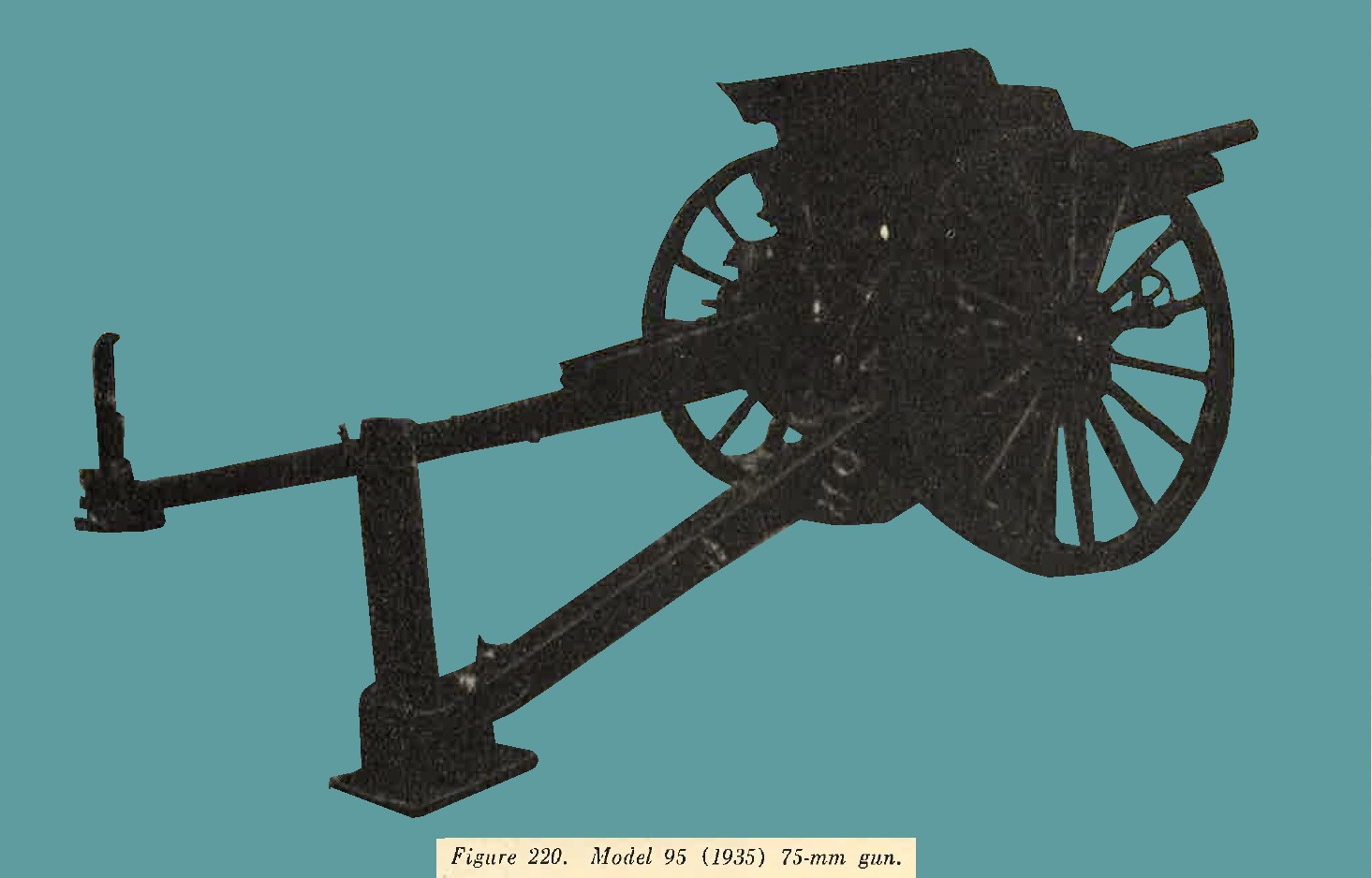 |
f. Model 14 (1925) 105-mm gun.
(1) General description. The 105-mm Model 14 (1925) gun (figure 221) is used for long range fire. There is no information, as of 1944, to show that this gun is still in production, and ir is felt that in all probability it has been superseded by the more modern Model 92 (1932).
This artillery piece was mounted on heavy wooden wheels, the weapon is normally tractor drawn, and is capable of being moved at a maximum speed of 8 miles per hour. As an alternative it may be drawn by 8 horses. The weapon possesses an interrupted screw breechlock, a hydropneumatic recoil mechanism, and a split trail.
(2) Characteristics.
|
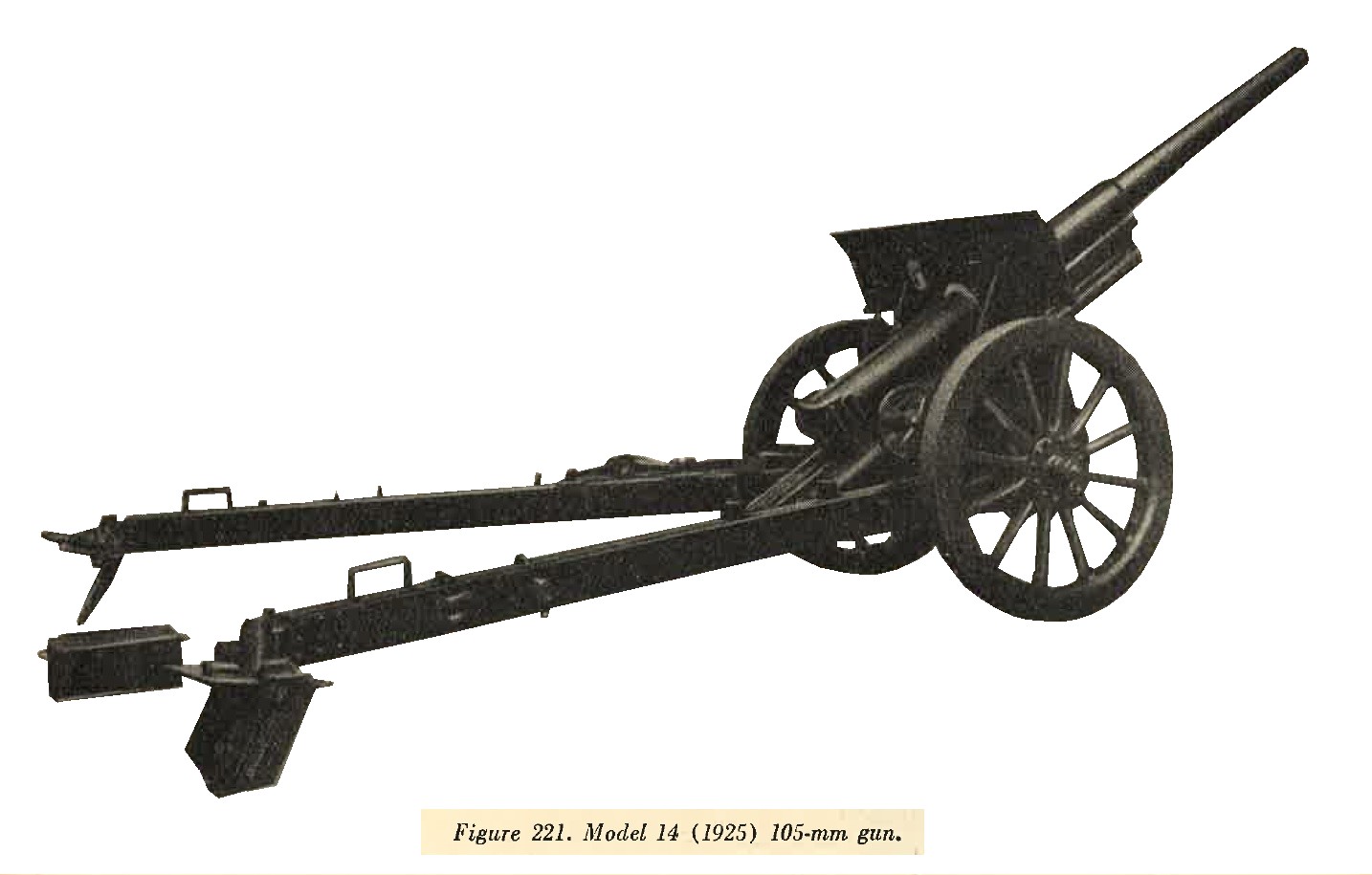 |
(3) Ammunition. Ammunition is semifixed. The following types of projectiles have been reported:
- High explosive (long pointed shell).
- High explosive.
- Sharpnel.
- Chemical.
- Armor piercing.
Time fuses are provided for the smoke, incendiary, and sharpnel projectiles. The standard Model 88 point detonating (instantaneous or delay) fuzes are used with HE and chemical shells.
g. Model 91 (1931) 105-mm Howitzer.
(1) Genral description. A light weight modern field piece (figure 222) possessing a hydropneumatic recoil mechanism, split trail, and interrupted screw breech mechanism. The weapon can be readily identified by the short barrel and long sleigh. Normally it is towed by six horses.
|
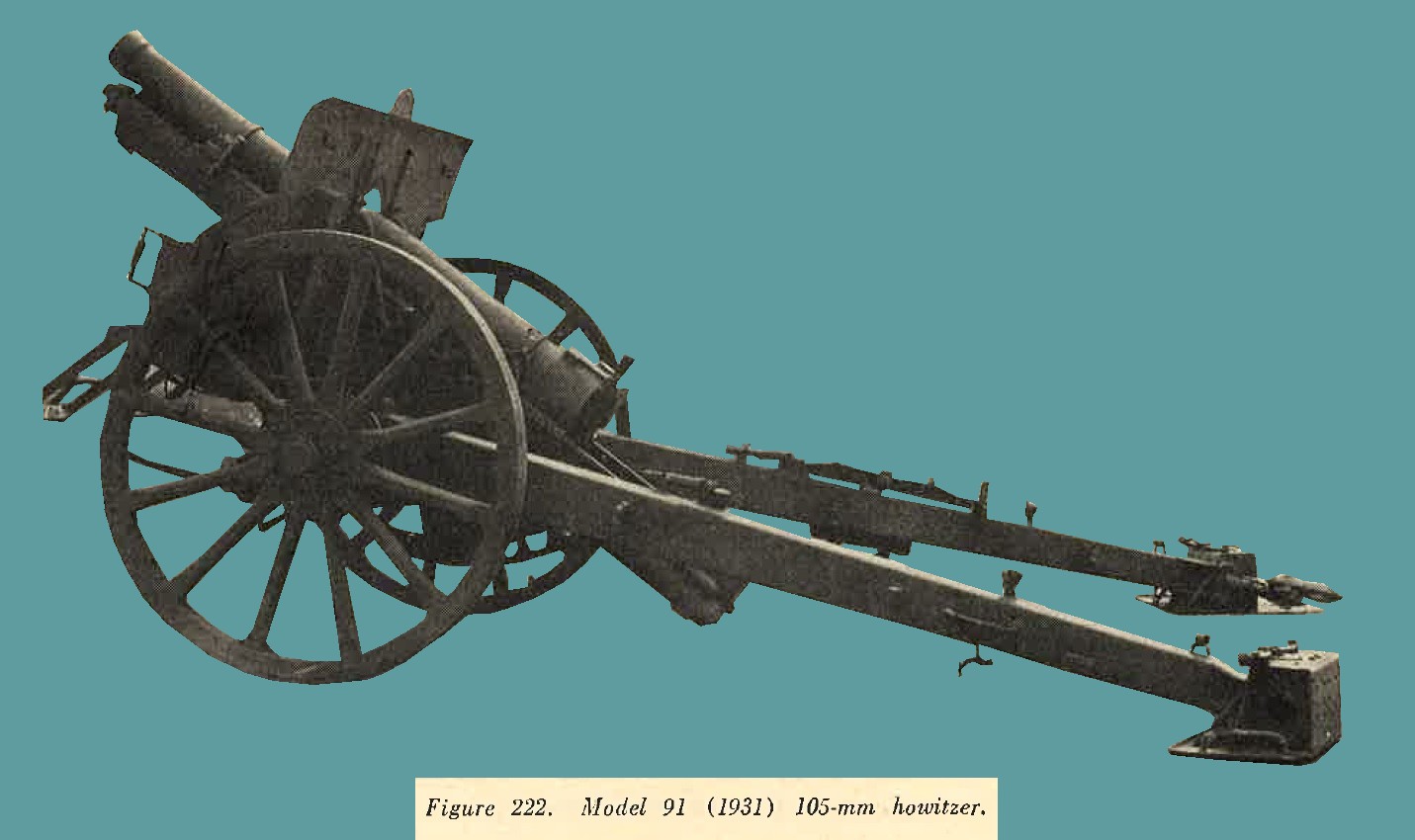 |
(3) Ammunition. Ammunition is semifixed. The following types of projectiles have been reported: - High explosive (long pointed shell).
- High explosive.
- Armor piercing.
- Sharpnel.
- Chemical.
h. Model 92 (1932) 105-mm gun.
(1) General description. It is considered that this weapon (figure 223) has superseded the Model 14 (1925) 105-mm gun. Readily recognized by its long slender barrel and trail, it has been designed [particularly for long range fire. Other distinctive features are the pronounced length of the sleigh and the three step interrupted thread breechlock. The recoil system is hydropneumatic. Mounted on heavily constructed wooden wheels with solid rubber tires, the weapon is normally tractor drawn, but may be drawn by a 5 ton truck.
|
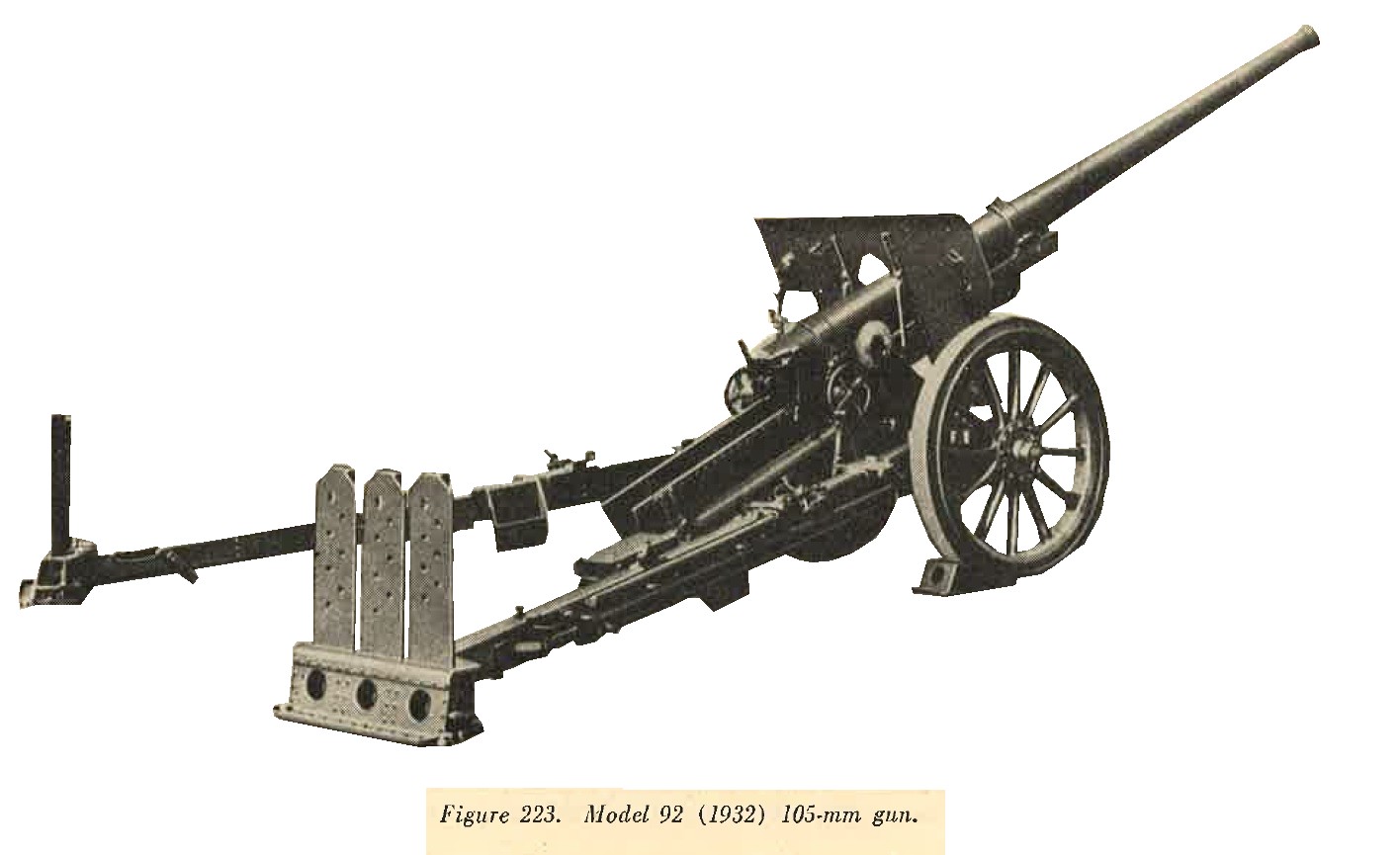 |
(3) Ammunition. Ammunition is semifixed. The following types of projectiles have been reported: - High explosive (long pointed shell).
- High explosive.
- Chemical.
- Armor piercing.
Time fuzes are provided for the smoke, incendiary, and chemical shells. The standard Model 88 point detonating (instantaneous or delay) fuzes are used with the HE and chemical shells.
i. Model 4 (1915) 150-mm howitzer.
(1) General description. One of the older type horse drawn weapons (figure 224) which nevertheless is still in service. For purposes of transportation the trail breaks in the middle. The barrel is removed from the cradle and placed on the rear portion of the trail, to which has been attached an extra pair of wheels. a limber is attached to each section, and each load may then be towed by six horses. The weapon possesses a vertical sliding breechlock, a hydropneumatic recoil mechanism, and a box type trail.
|
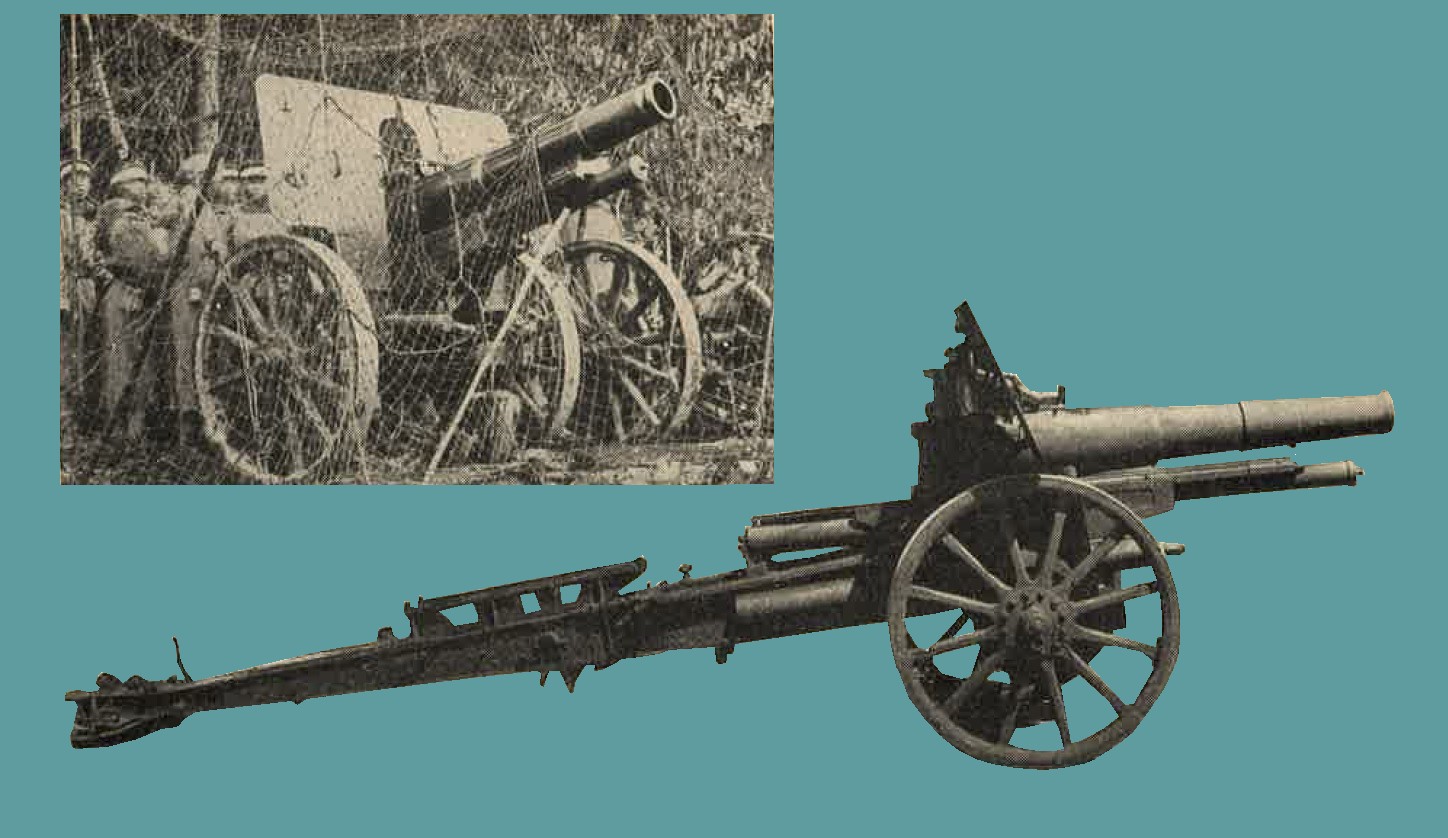
Figure 224. Two views of Model 4 (1915) 150-mm howitzer. |
(3) Ammunition. Ammunition is semifixed. The following types of projectiles have been reported:
- High explosive.
- Armor piercing.
- Sharpnel.
- Chemical.
Time fuzes are provided for the smoke, incendiary, and sharpnel projectiles. The standard point detonating (instantaneous and delay) fuzes are used with the HE and chemical shells.
j. Model 89 (1929) 150-mm gun.
(1) General description. A tractor drawn weapon (figure 225) of improved design employed for long range fire. it is designated by the Japanese Army as a heavy field artillery piece. Although manufactured was commenced in 1929, it is believed that issue was not completed until 1937. For purposes of transportation the barrel is removed from the cradle and placed on a separate carriage. The weapon has a split trail, hydropneumatic recoil mechanism, and an interrupted thread block.
(3) Ammunition. AP, HE, Sharpnel, HE (long pointed shell). |
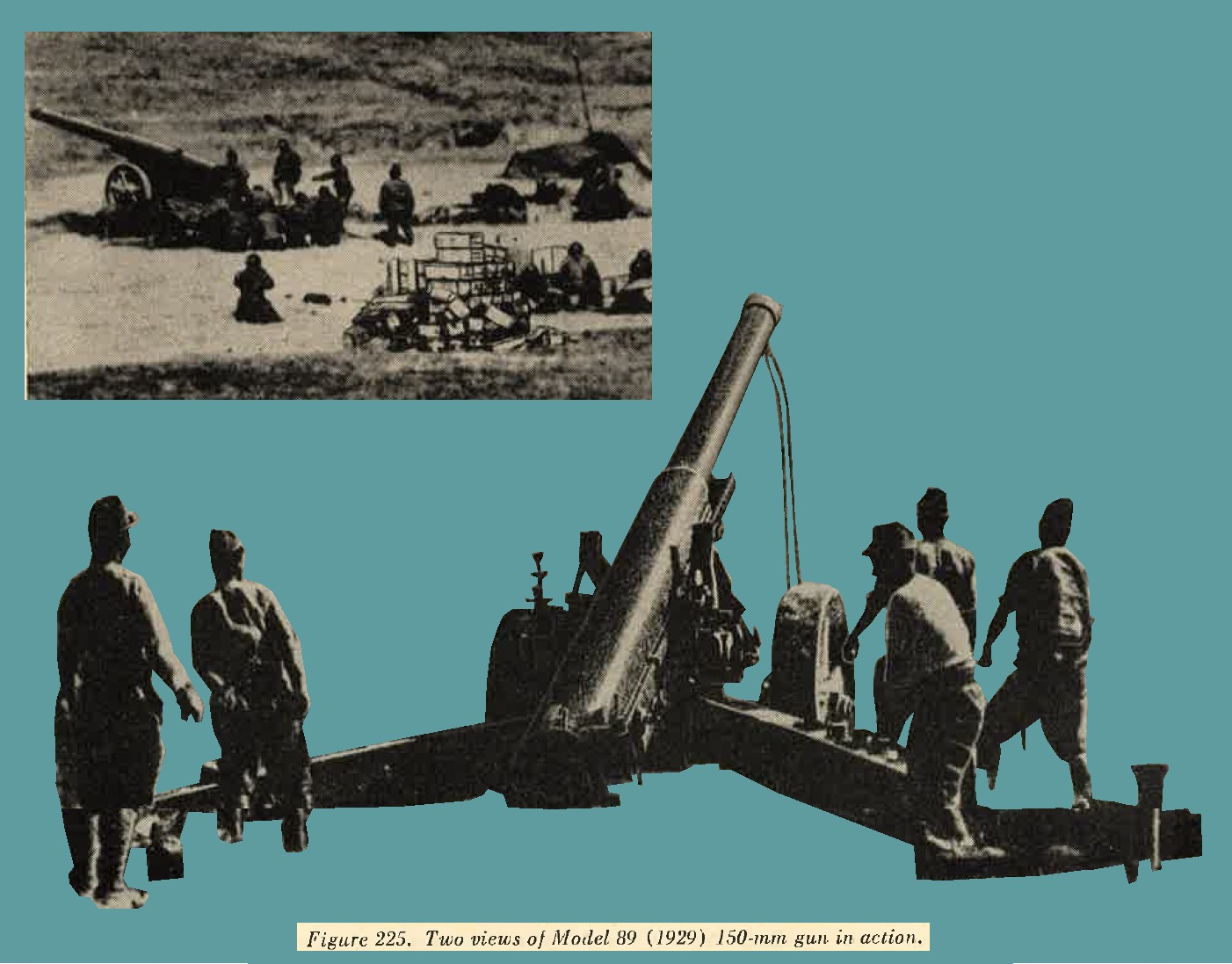 |
k. Model 96 (1936) 150-mm Howitzer.
(1) General description. A well designed and effective weapon (figure 226) which is, to date (1944) the most modern of its type known to be possessed by the Japanese. It is reported that three modifications exist. Variations, however, are believed to be extremely slight. Mounted on sturdy, rubber shod, wooden wheels, the weapon is normally tractor drawn. One of the outstanding characteristics is the extreme elevation of 75 degrees which can be obtained. This, however, can be used only when a deep loading pit is dug beneath the breech. It is probable that the weapon could not be fired at an elevation greater than 45 degrees without construction of such a pit. Other features are a long split trail, interrupted thread breechlock, and a hydropneumatic recoil mechanism.
(2) Characteristics.
(3) Ammunition. Semifixed; HE, AP, Sharpnel, smoke, incendiary tracer. |
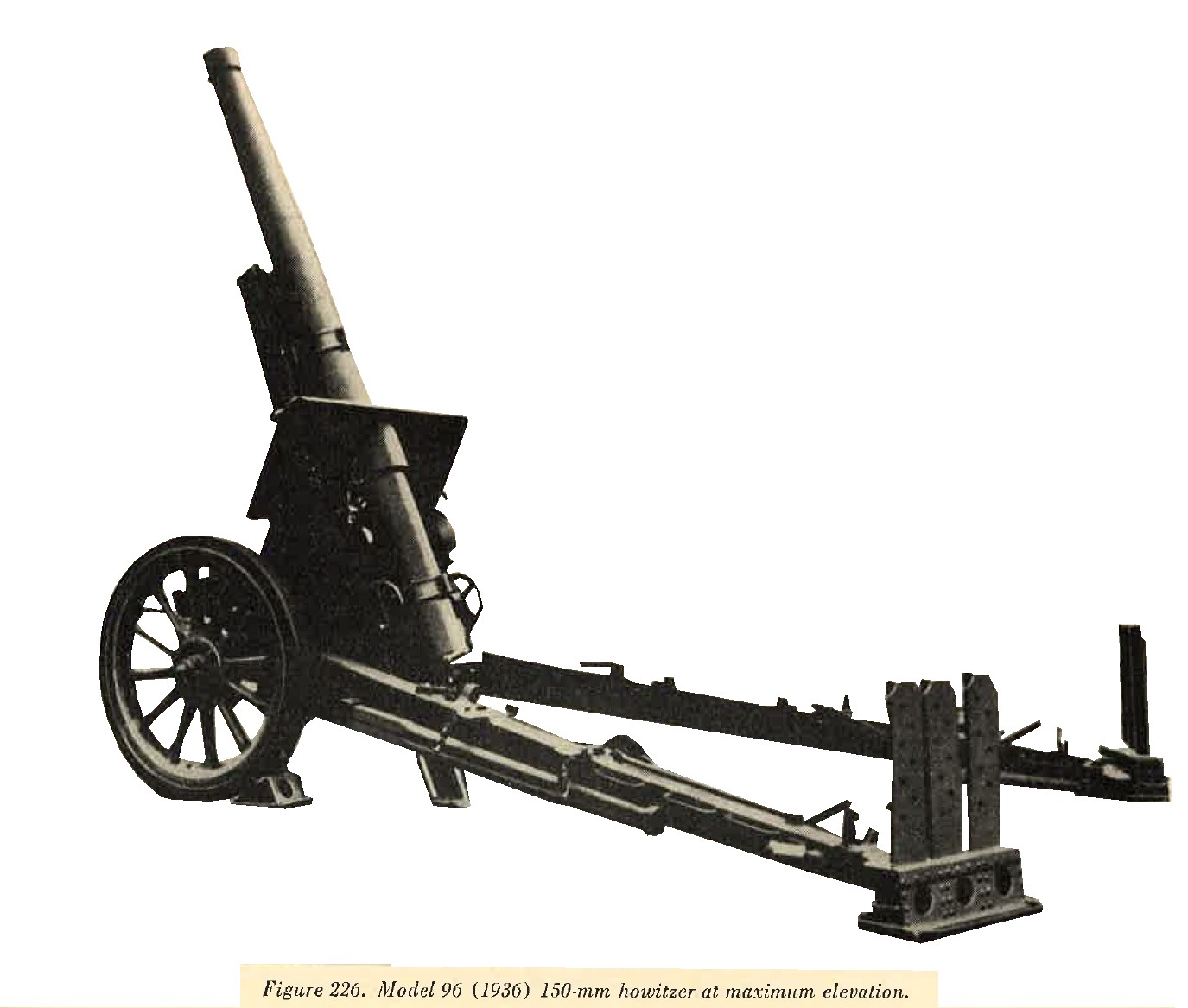 |
l. Model 45 (1912) 240-mm Howitzer.
It is reported that this piece has a maximum range of 11,000 yeards, firing a semifixed round weighing approximately 400 pounds. It is broken down and transported on 10 vehicles. (See figure 227).
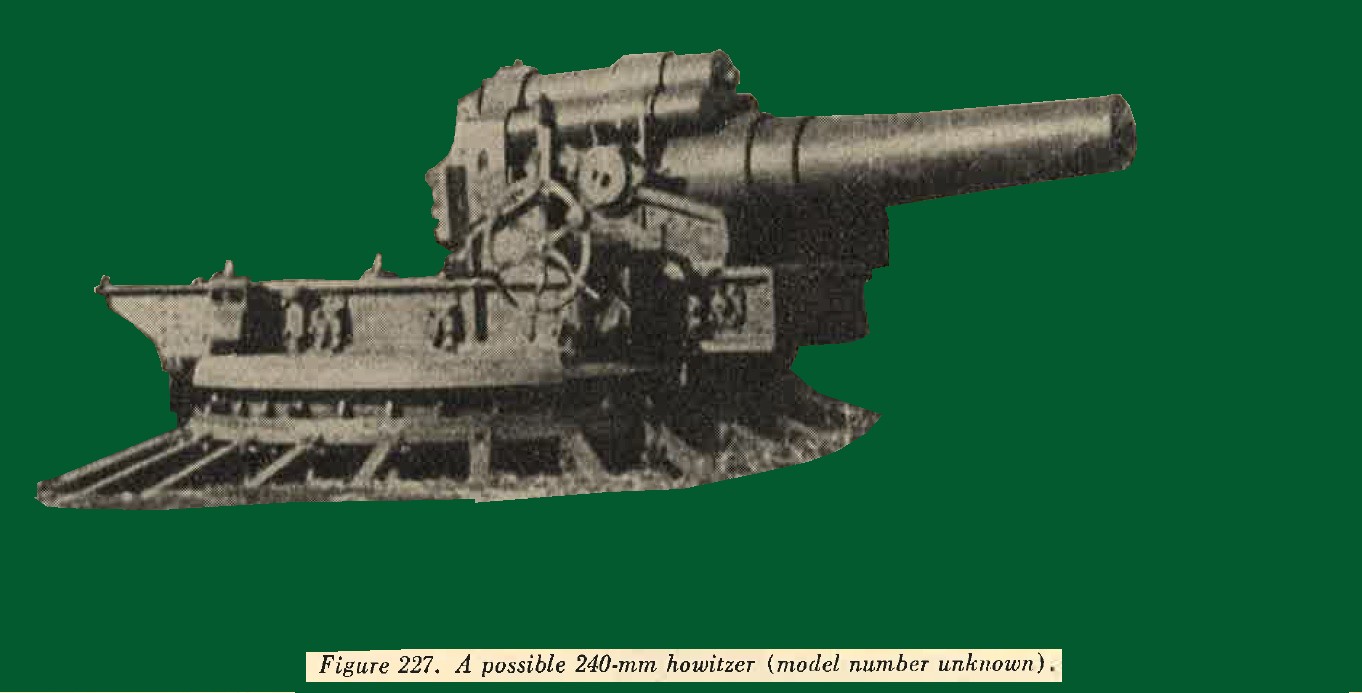
m. Miscellaneous heavy artillery.
in recent years the Japanese have bought 17-cm, 21-cm and 24-cm weapons from Germany and therefore Japanese copies of these may be expected. In addition to the above, the following heavy artillery pieces have been reported but none have been captured, therefore the characteristics given below have not been confirmed.
| Caliber | Type | Length of bore | Muzzle velocity | Type of shell | Weight of shell | Maximum range | Elevation | Weight in action | Remarks |
| 24-cm | Railway gun | ----- | 3,560 ft/sec | HE | 440 lbs | 54,500 yrds | ----- | 35 tons | Several types reported |
| 30-cm | Howitzer M18 | 196 | 1,310 ft/sec | HE | 880 lbs | 12,750 yrds | 46 deg | 14.72 tons | Unconfirmed |
| 30-cm | Howitzer M18 | 324 | 1,140 ft/sec | HE | 1,100 lbs | 16,600 yrds | 48 deg | 19.76 tons | Do. |
| 41-cm | Howitzer (seige) | 538 | 1,760 ft/sec | HE | 2,200 lbs | 21,200 yrds | 45 deg | 80 tons | Do. |

3. WWII JAPANESE ANTIAIRCRAFT ARTILLERY.
a. Inroduction. It has been emphasized to the Japanese soldier that effective aircraft defense depends on the use of all arms. Many of the weapons primarilyt designed for ground action and previously described under infantry armament also are designed to perform an antiaircraft role.
(1) The new basic infantry weapon Model 99 (1939) 7.7-mm rifle (figure 228) has a rear sight, with arms calculated to give the rifleman the approximate lead required to hit a low flying plane.
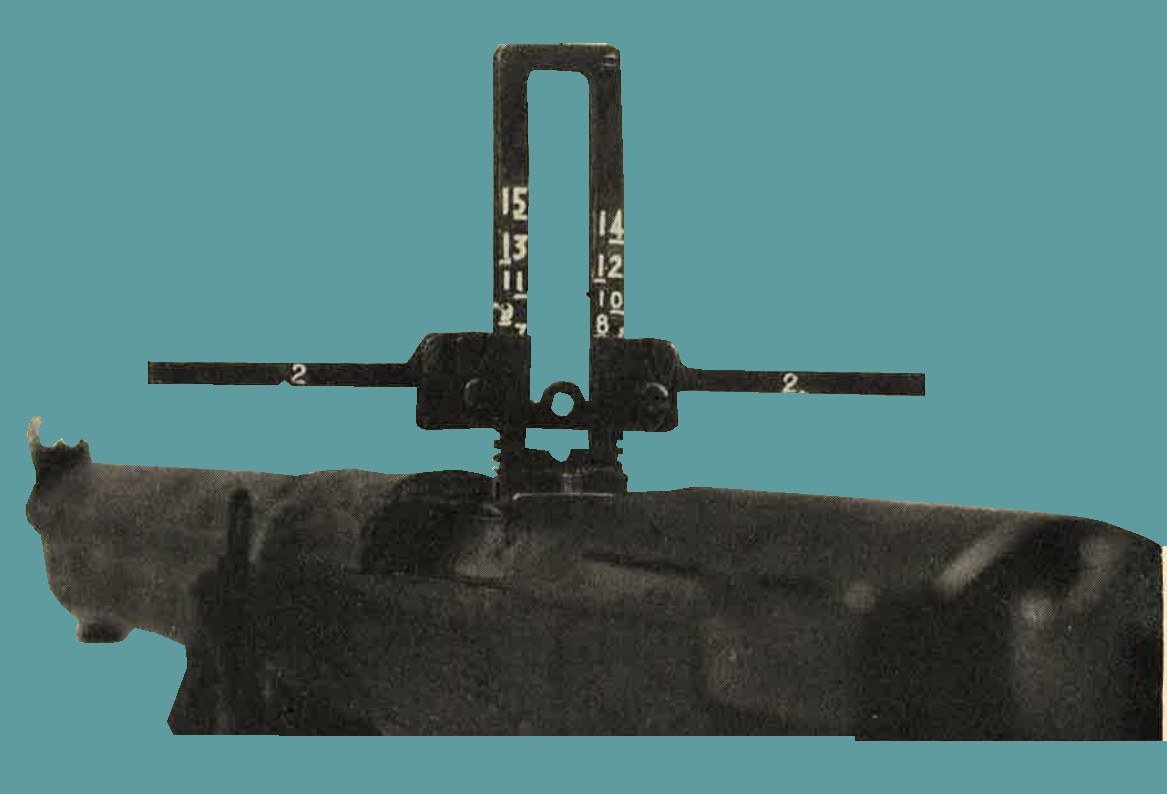
Figure 228. Rear sight on Model 99 (1939) 7.7-mm rifle.
(2) The Model 92 (1932) 7.7-mm heavy machine gun (figure 229) is provided with an antiaircraft adapter as illustrated in figure 229, and standard antiaircraft ring sights.
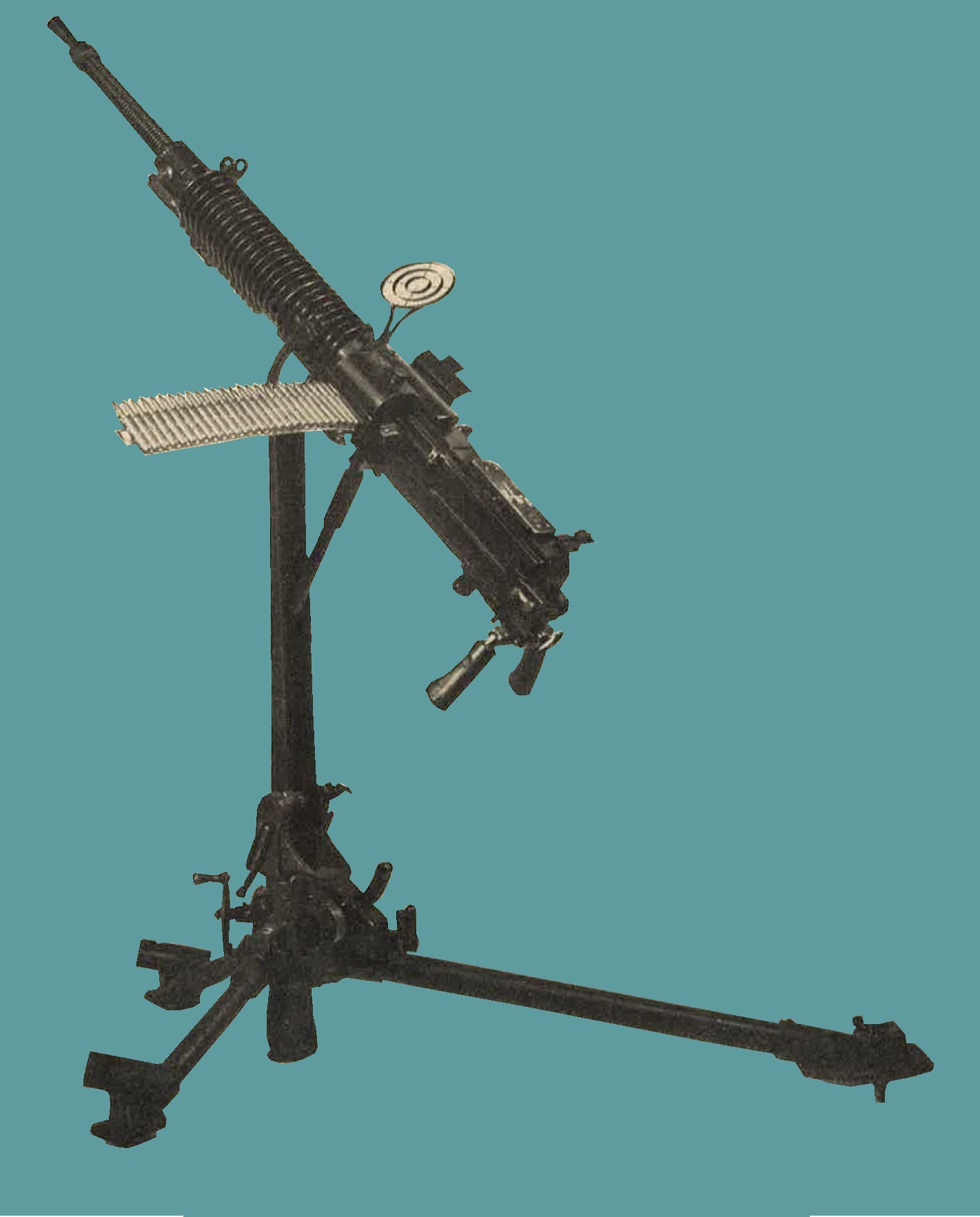
Figure 229. Model 92 (1932) 7.7-mm HMG with AA adapter.
(3) The Lewis type Model 92 (1932) 7.7-mm machine gun (figure 230) has a standard mount which can be adapted for antiaircraft defense (see figure 230)
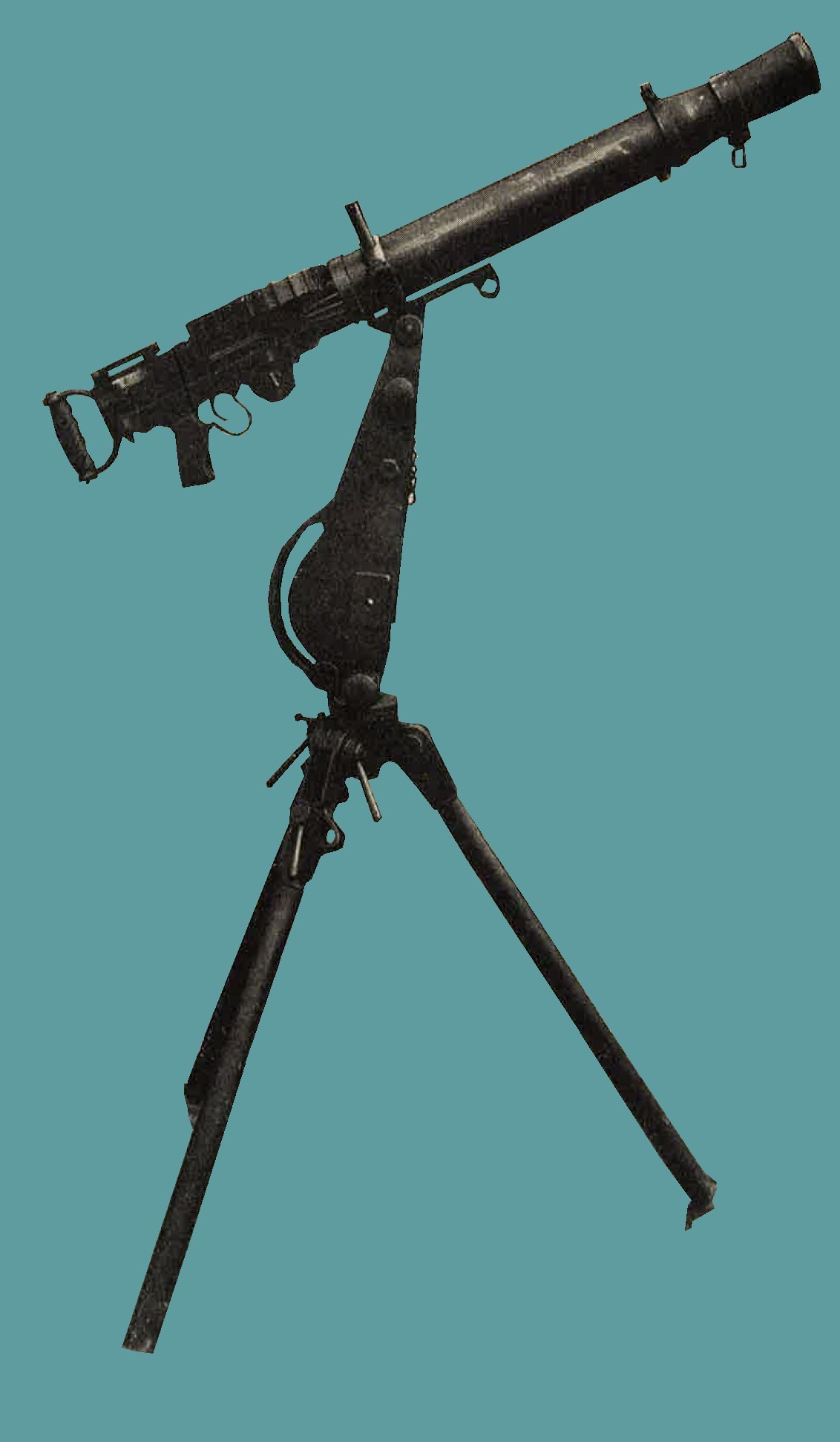
Figure 230. Model 92 (1932) 7.7-mm machine gun (Lewis type) in position for AA fire.
(4) The Model 93 (1933) 13-mm machine gun is shown in figure 231 in dual mount for antiaircraft fire.
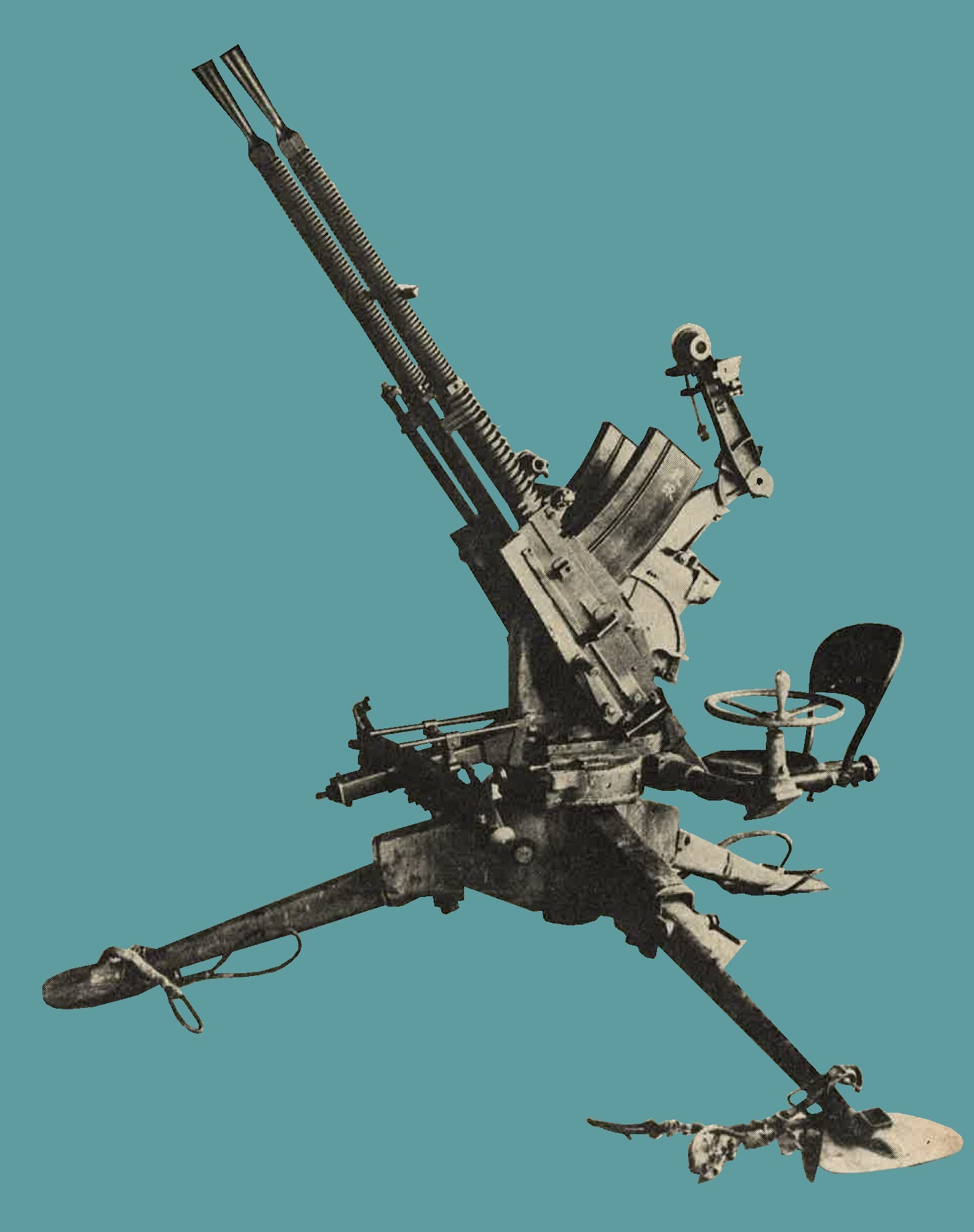
Figure 231. Model 93 (1933) 13-mm machine gun (dual mount).
(5) The Model 98 (1938) 20-mm AA/AT automatic cannon and probably the 70-mm barrage mortar (Chapter 9, Section II) have been designed principally for an antiaircraft role.
(6) In addition to the more common antiaircraft weapons described in detail on the following pages, 120-mm and 127-mm naval antiaircraft guns have been encountered. Th elatter in dual mounts.
(7) There are indications that Japanese heavy AA artillery is possibly more modern and a larger caliber than the standard 75-mm model 88, which is the only heavy antiaircraft weapon captured in quantity to date.
(8) Tabulated below are the estimated capabilities of Japanese aircraft weapons.
| NUM | CALIBER | WEAPONS | MAXIMUM RATE OF FIRE | MAXIMUM VERTICAL RANGE |
| 1 | 7.7-mm | Model 92 heavy machine gun | 450 | 4,000 |
| 2 | 7.7-mm | Model 92 (Lewis) machine gun | 600 | 4,000 |
| 3 | 13.2-mm | Model 93 machine gun | 450 | 13,000 |
| 4 | 20-mm | Model 98 automatic cannon | 200 | 12,000 |
| 5 | 25-mm | Model 96 naval automatic cannon | 300 | 14,000 |
| 6 | 40-mm | Vickers type | ----- | 14,000 |
| 7 | 75-mm | Model 88 gun | 15 | 30,000 |
| 8 | 105-mm | Model 14 gun | 10 | 36,000 |
| 9 | 127-mm | Model 89 gun | 10 | 40,000 |
Information concerning fire control equipment used with some of the weapons listed will be found in Chapter 10.
b. Model 96 (1936) type 2, 25-mm antiaircraft - antitank automatic cannon.
1. General description. This (Figure 232) is gas operated, air cooled, magazine-fed, full automatic,or semiautomatic machine cannon. It has been been found in dual and triple fixed mounts, emplaced customarily around air strips for antiaircraft defense. However, it is capable of 10 degree depression which makes it effective for direct fire against ground targets. Traverse and elevation are controlled by hand wheels.
2. Characteristics.
|
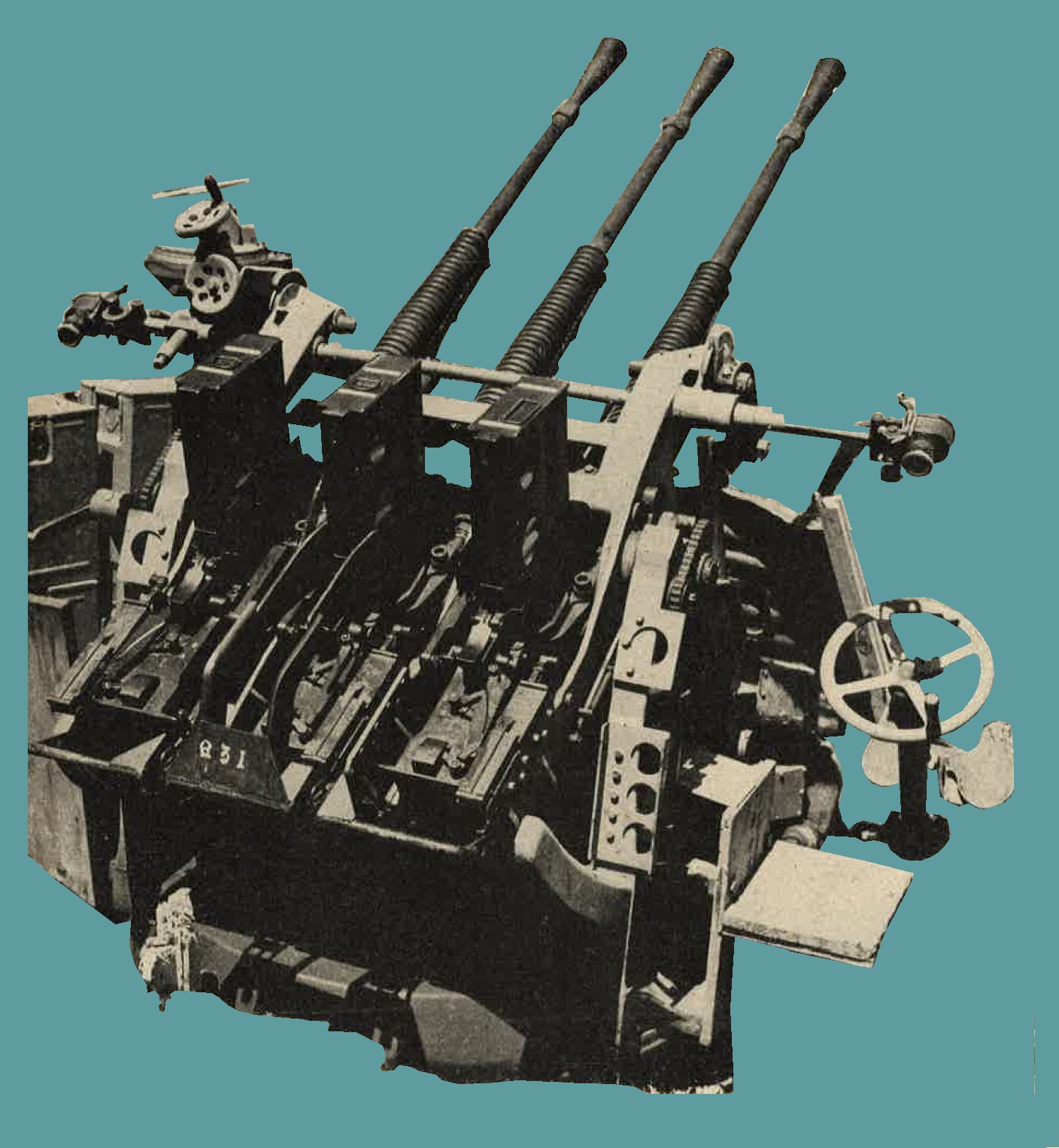
Figure 232. Rear view of Model 96 (1936) type 2, 25-mm AA/AT automatic cannon, triple mount. |
3. Ammunition. This weapon is furnished with high explosive tracer, high explosive, and armor piercing tracer ammunition.
c. 40-mm single and dual antiaircraft and antitank automatic cannon.
(1) General description. This weapon (figure 233) is a Vickers type recoil operated, water cooled, link belt fed, automatic or semiautomatic machine cannon. several of these have been captured. Single mounted guns were marked "Vickers - Armstrongs 1931", but the dual mounted guns were Japanese manufactured copies. Elevation and traverse are obtained by hand. The weapon is fitted with a telescopic calculating sight and an automatic fuze setter.
(2) Characteristics.
(3) Ammunition. Armor piercing high explosive, high explosive with time fuze, high explosive with point detonating fuze, and tracer. |
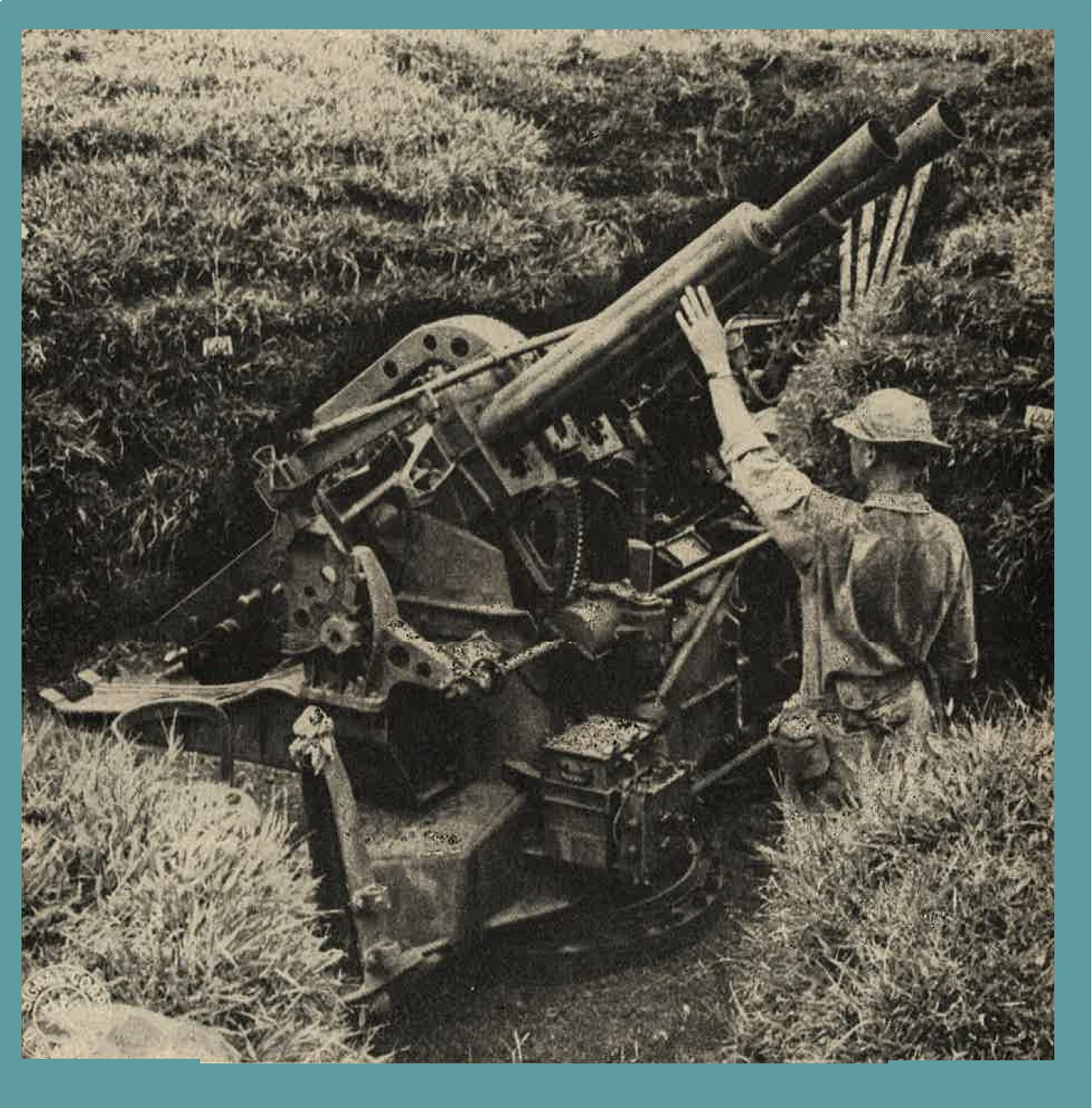
Figure 233. Dual mounted 40-mm Vickers type 40-mm AA/AT automatic cannon. |
d. Model 88 (1928) 75-mm antiaircraft gun.
(1) General description. This has been the standard Japanese mobile heavy antiaircraft weapon (figure 234). Specimens have been found on all airfields captured from the Japanese. It is a truck drawn weapon. For firing, the wheels are removed, and the gun is supported by five outriggers. During transit, the barrel is dropped back on the cradle extension and secured to the ends of two outriggers. The gun has a hydropneumatic variable recoil system and a semiautomatic horizontal, sliding wedge breech mechanism. Fire control instruments captured indicate that the older system of transmitting corrections to the gun pointers vocally is still in use. However, evidence is on hand that an electrical data transmission system and operation by the "Matched Pointers" method is used sometimes. This gun has been used against ground targets.
(2) Characteristics.
(3) Ammunition. High explosive, sharpnel, and incendiary. |
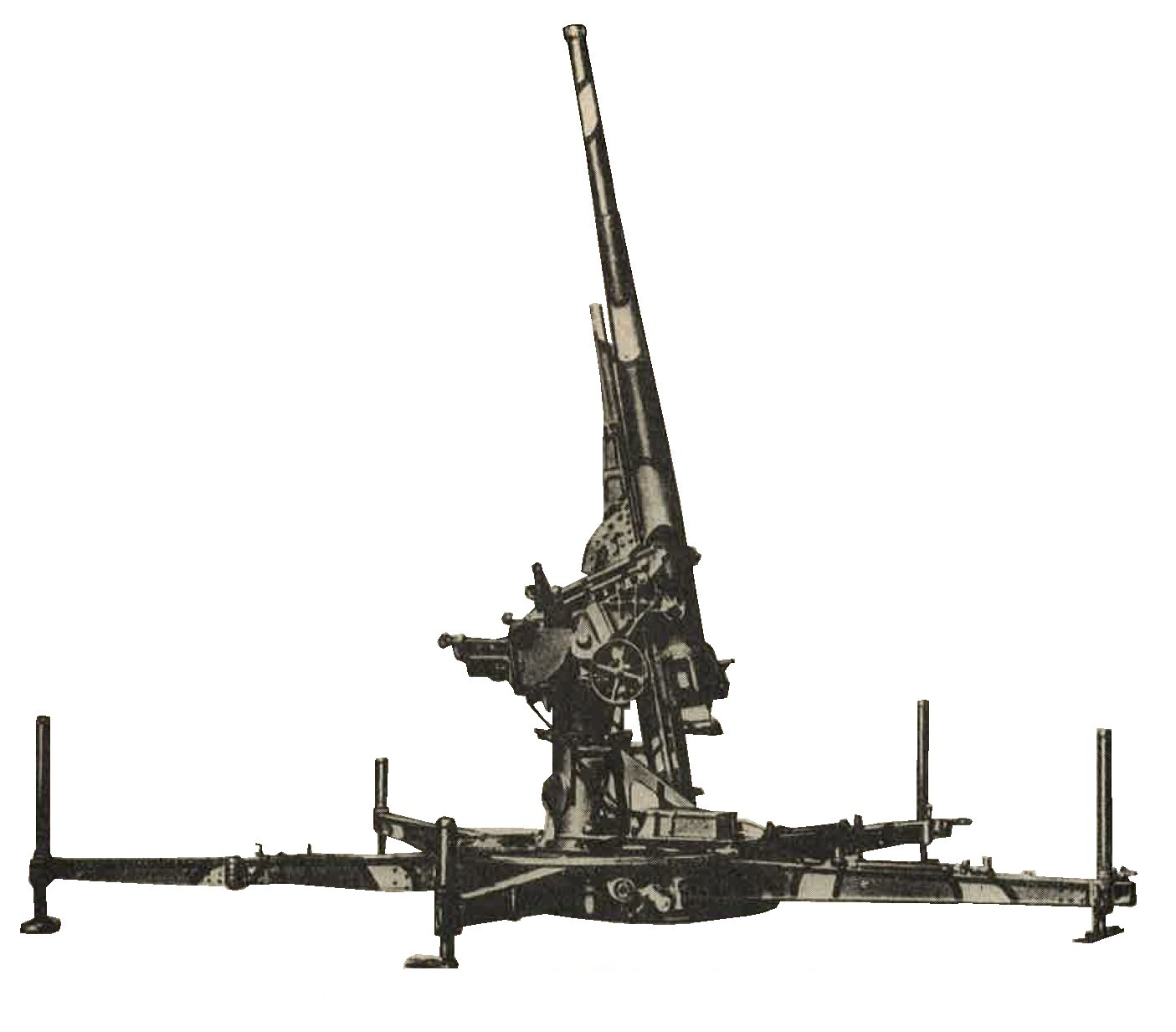
Figure 234. Model 88 (1928) 75-mm antiaircraft gun. |
e. Model 14 (1925) 105-mm antiaircraft gun.
(1) General description. This is the heavist mobile Japanese antiaircaft weapon (figure 235) in use at present (1944). As originally designed, it was not satisfactory, and probably has been redesigned by this time. It has a pedestal mount, horizontal sliding breechblock, and a hydropneumatic recil system. In firing position the wheels are detached and the gun rests on six outriggers. Thiry to 45 minutes are required to prepare the gun for action. The fuze setter is continuous and automatic.
(2) Characteristics.
(3) Ammunition. High explosive. |
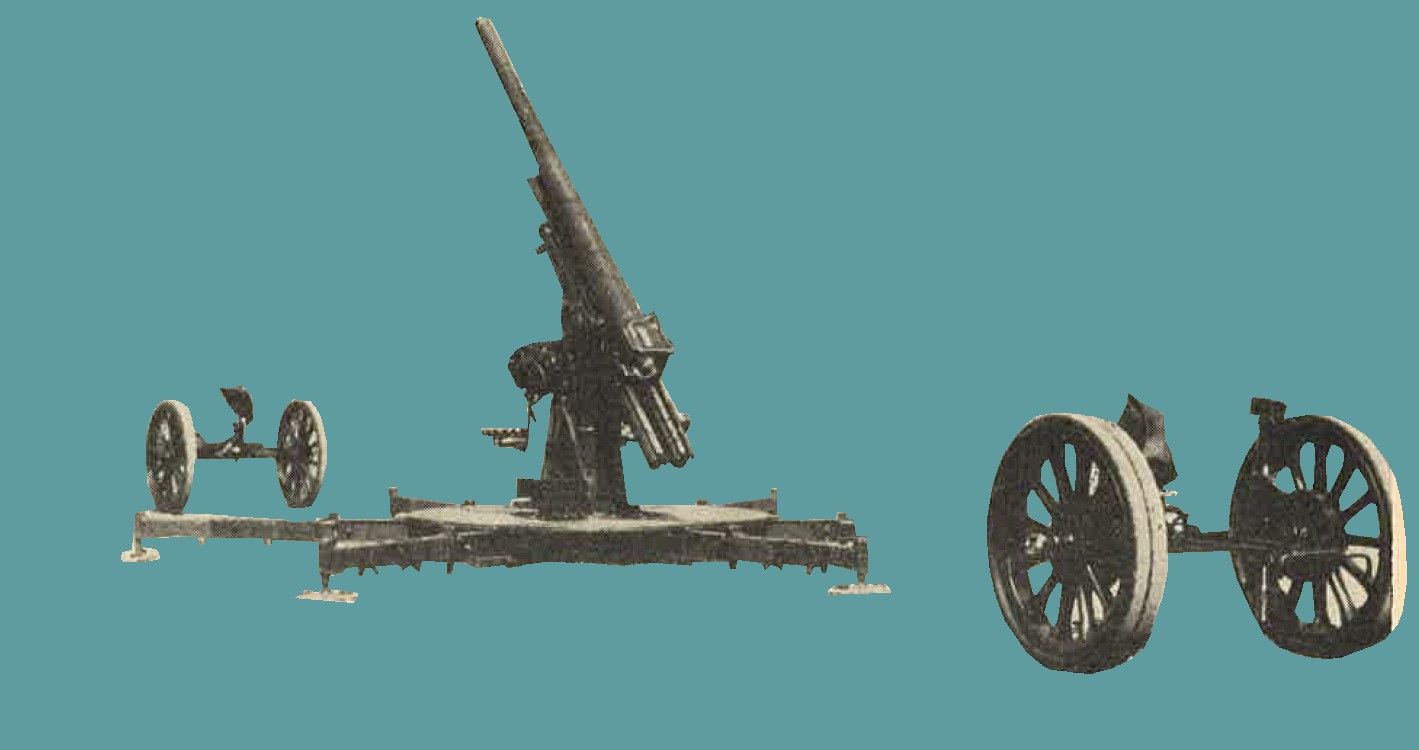
Figure 235. Model 14 (1925) 105-mm antiaircraft gun showing detachable wheels used for transport of piece. |

4. NAVAL WEAPONS.
a. General In all areas captured from Japanese, naval guns have been found installed for coastal and antiaircraft defense. These weapons have been of standard naval design, and in many cases appear to have been removed complete (including turret, mounting, etc.) from the decks of the ships. It is known that the Japanese have recovered the armamentfrom beached ships and transferred them to land posiitons.
Since they are on pedestal mounts with wide traverse, they not only are used for coastal defense but also may be brought to bear against inland targets. On the following pages are found examples of the naval guns which are most likely to be encountered. Of these weapons the Model 10 (1921) 3-inch gun has been most frequently installed. In addition to thoseweapons described, guns of 127-mm (5 inch) and 8 inch calibers have been captured. The 127-mm guns have been found mounted in pairs in turrets which permit antiaircraft fire.
b. Model 10 (1921) 3-Inch gun.
(1) General description.
The Japanese refer to this weapon (figure 236) as the "8-cm, 40 caliber, high angle gun". actual measurements show it to be 76.2-mm (3 inch). A dual purpose piece of pedestal mount, it is used as antiaircraft as well as coastal defense. To compensate for muzzle preponderance, an equilibrator is mounted in the pedestal. The recoil system is hydropneumatic, and the breechblock is the sliding wedge type. A noticeable feature is the unusually long recoil cylinder on the top of the tube.
(2) Characteristics.
(3) Ammunition. High explosive. |
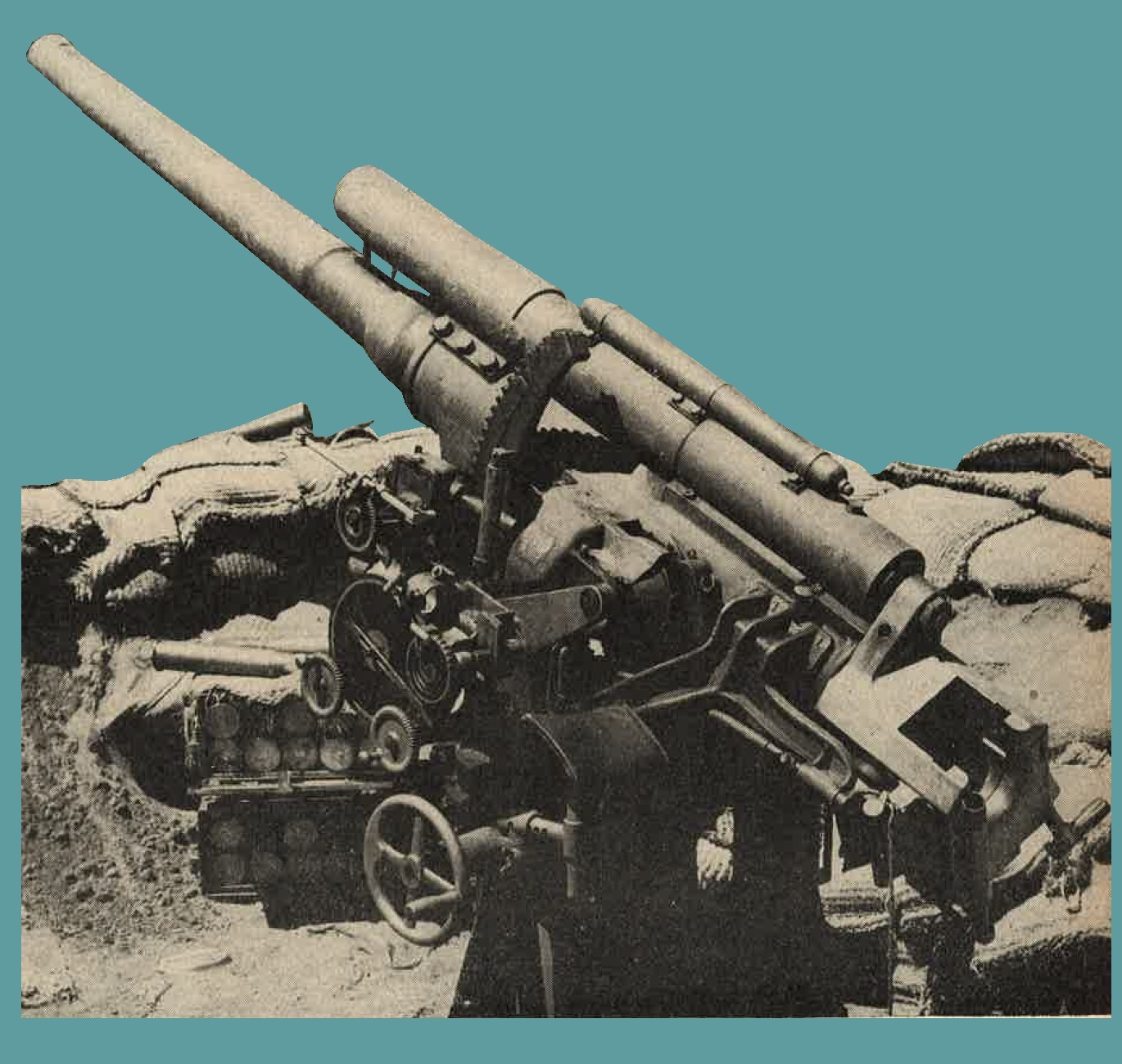
Figure 236. Model 10 (1921) 3-inch gun. |
c. Model 3 (1914) 12-cm Naval gun.
(1) General description.
Guns of this type (figure 237) have been encountered on a number of islands in the Pacific area. No provision has been made on the gun illustrtated in figure 237 to provide for use as an antiaircraft weapon, but other weapons of this caliber allegedly are munted for such purposes. It has a hydropneumatic recoil system and an interrupted thread breechblock.
(2) Characteristics.
(3) Ammunition. Separate loading high explosive with a cartridge case used for obturation. |
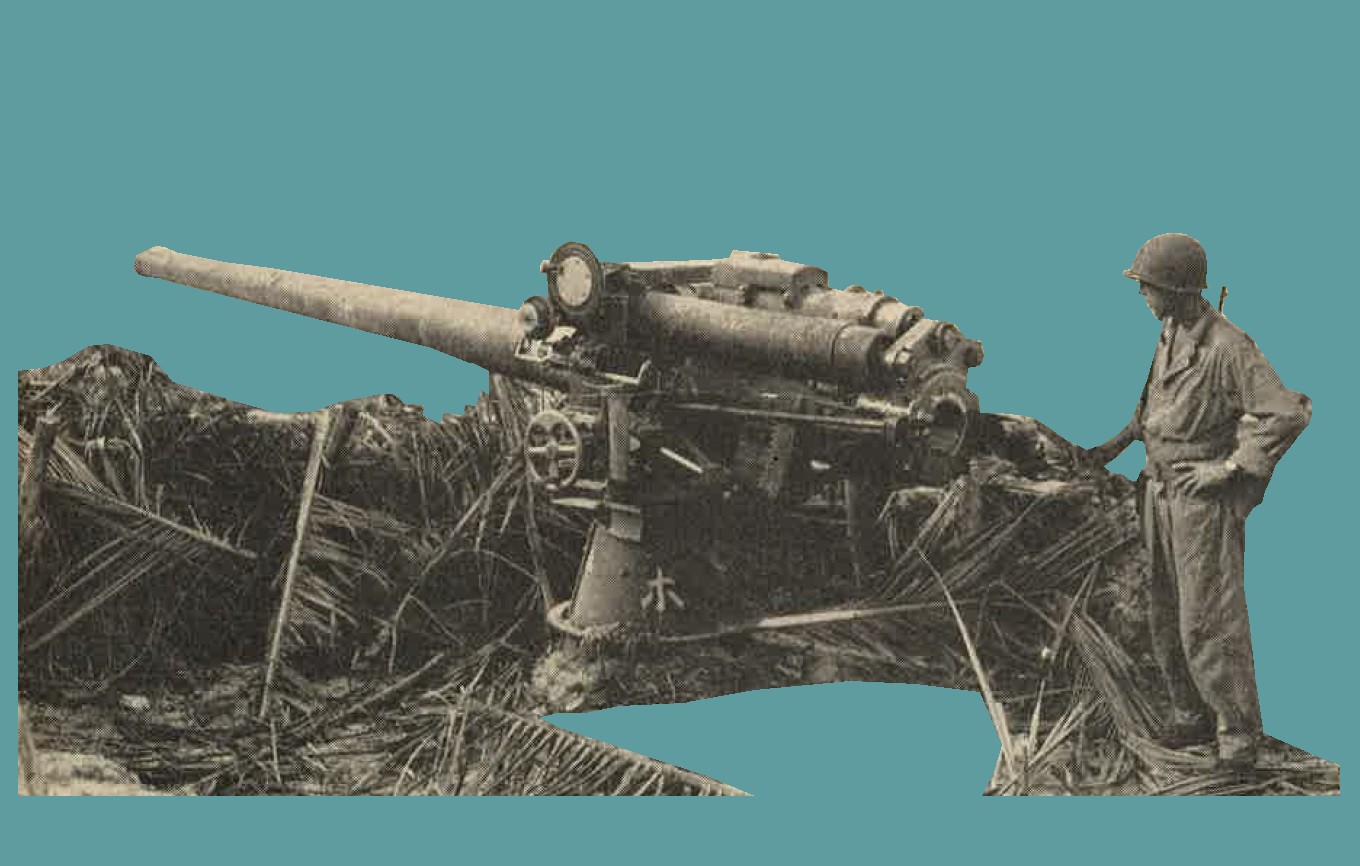
Figure 237. Model 3 (1914) 12-cm naval gun. |
d. Model 3 (1914) 14-cm naval gun.
(1) General description.
An orthodox type of naval gun and pedestal mount (figure 238) which has been used as a coastal defense weapon. It has been found both with a shield and mounted in a hand operated turret (casemate). It has a hydropneumatic recoil system and truncated cone, interrupted thread breechblock.
(2) Characteristics.
(3) Ammunition. Separate loading ammunition is used. The prokectiles recovered were high explosive, with fuzes designed for use against vessels. |
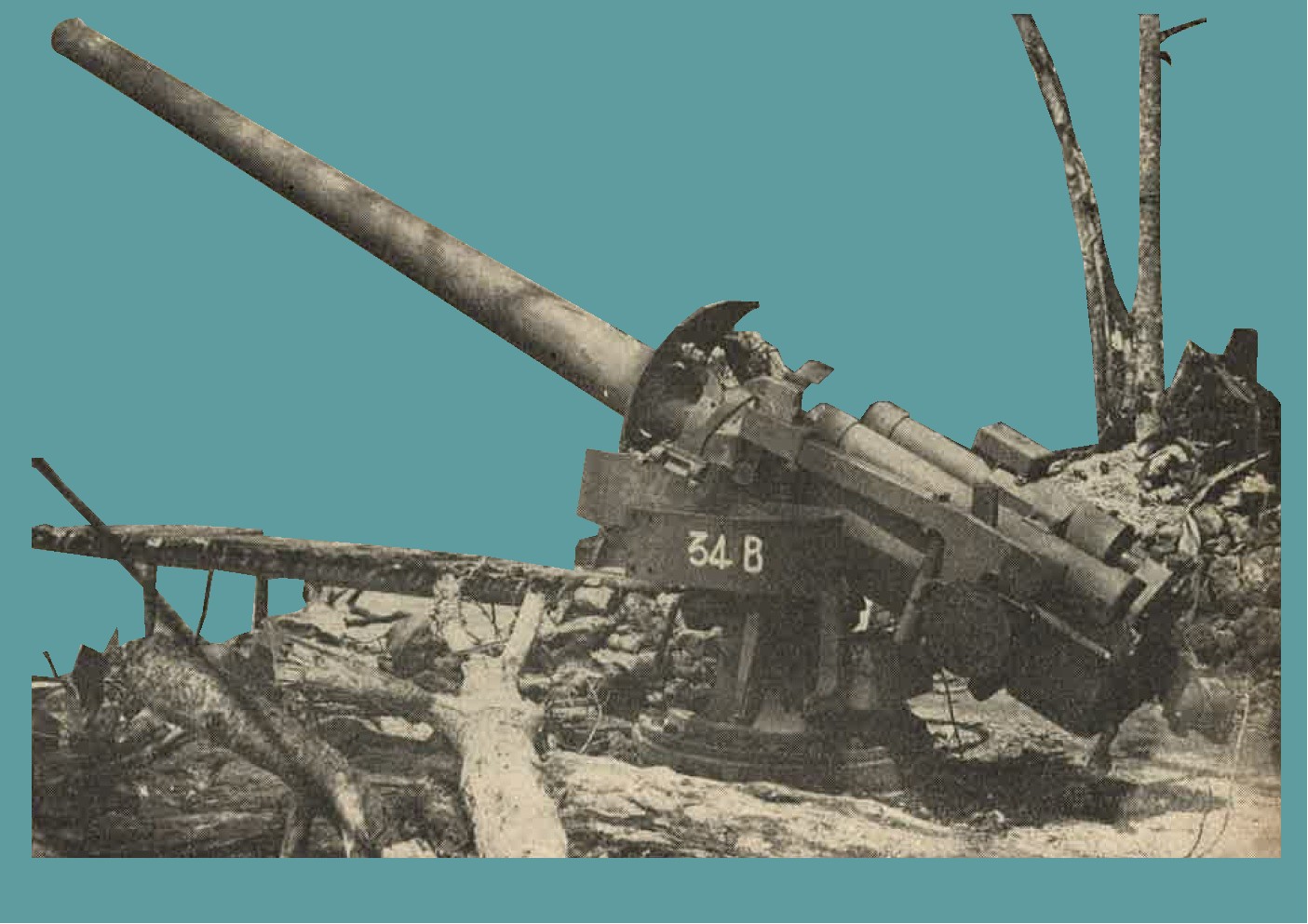
Figure 238. Model 3 (1914) 14-cm naval gun. |
